Create a Thriving Native Garden
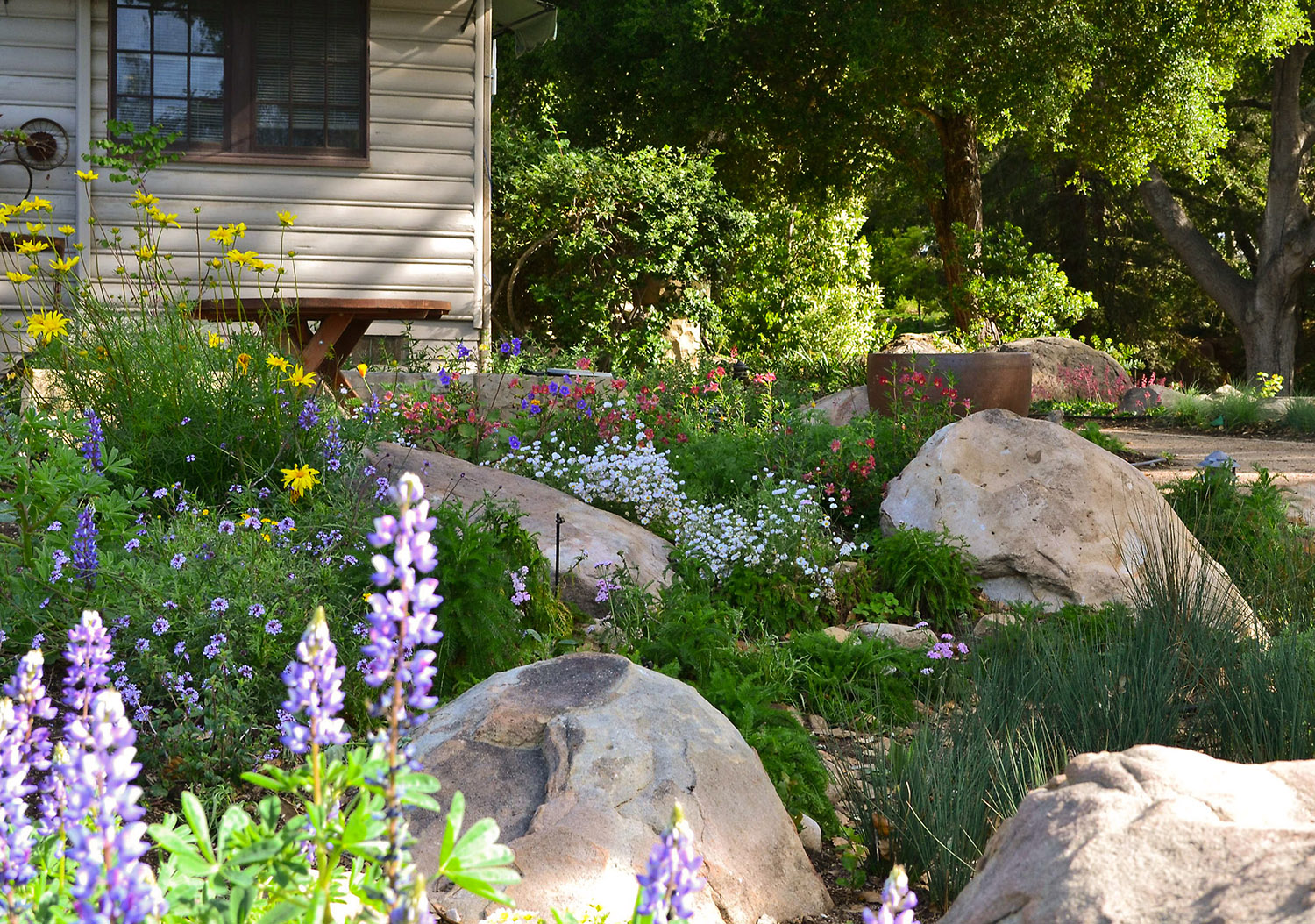
Thriving Ecosystems
It Begins With Native Plants
There are many reasons to garden — connection to nature, beauty, food production, habitat for wildlife — and adding native plants to any garden favors all those outcomes. From ensuring year-round blooms that support pollinators for your veggie garden to providing a hummingbird haven on your patio, native plants have what it takes to transform yards and neighborhoods into thriving natural ecosystems.
Start Small &
Watch It Grow
Some say that small is beautiful, and this certainly applies to approaching a native plant garden. It’s okay to start small. Even a single potted plant or a small bed of native plants can attract a critical pollinator, beneficial insect, or bird. The more native plants that get incorporated into a landscape, the more potential for attracting abundant, living diversity to our communities. As you continue building your garden, you can think about the specific benefits you’d like to achieve, from attracting food for nesting birds to ensuring year-round blooms for the enjoyment of all.
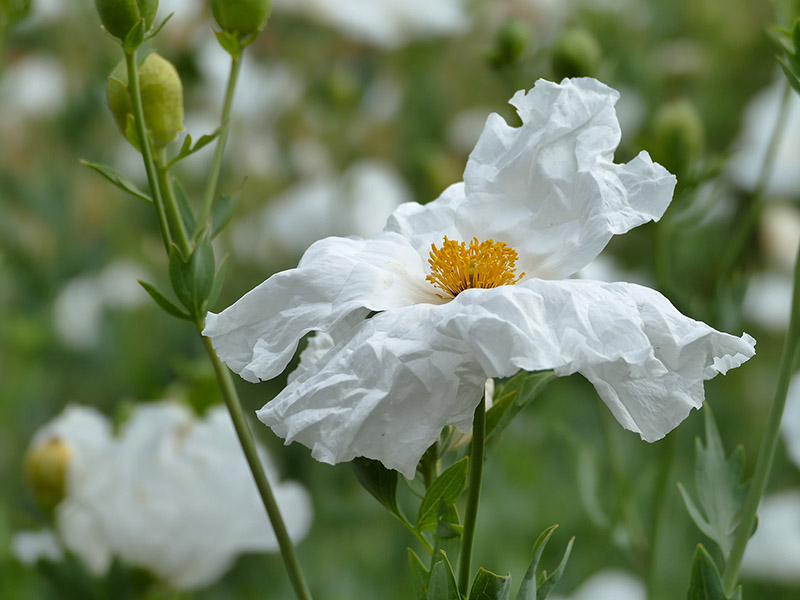
Pro Tips & Tricks
How to create a native plant garden that is functional and beautiful and provides year-round habitat for a variety of wildlife
Create Your Thriving Garden
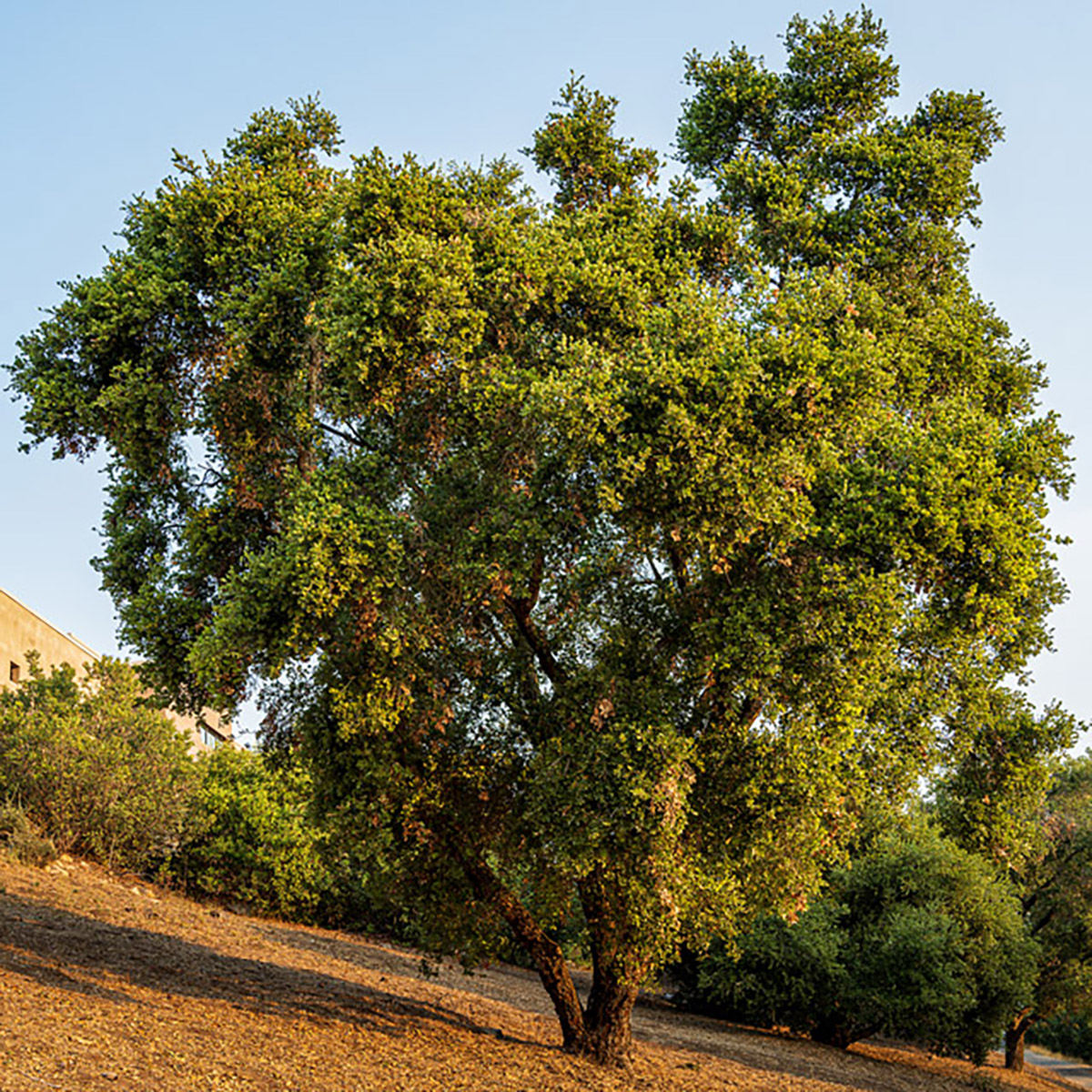
Right Plant, Right Place
California is a large, diverse place, so not all plants will thrive in your garden. Before acquiring and installing plants, take a look at the conditions of your site. How much sun does it get every day? Are your soils sandy or full of clay? You can find a variety of native plants well suited to different landscape characteristics.
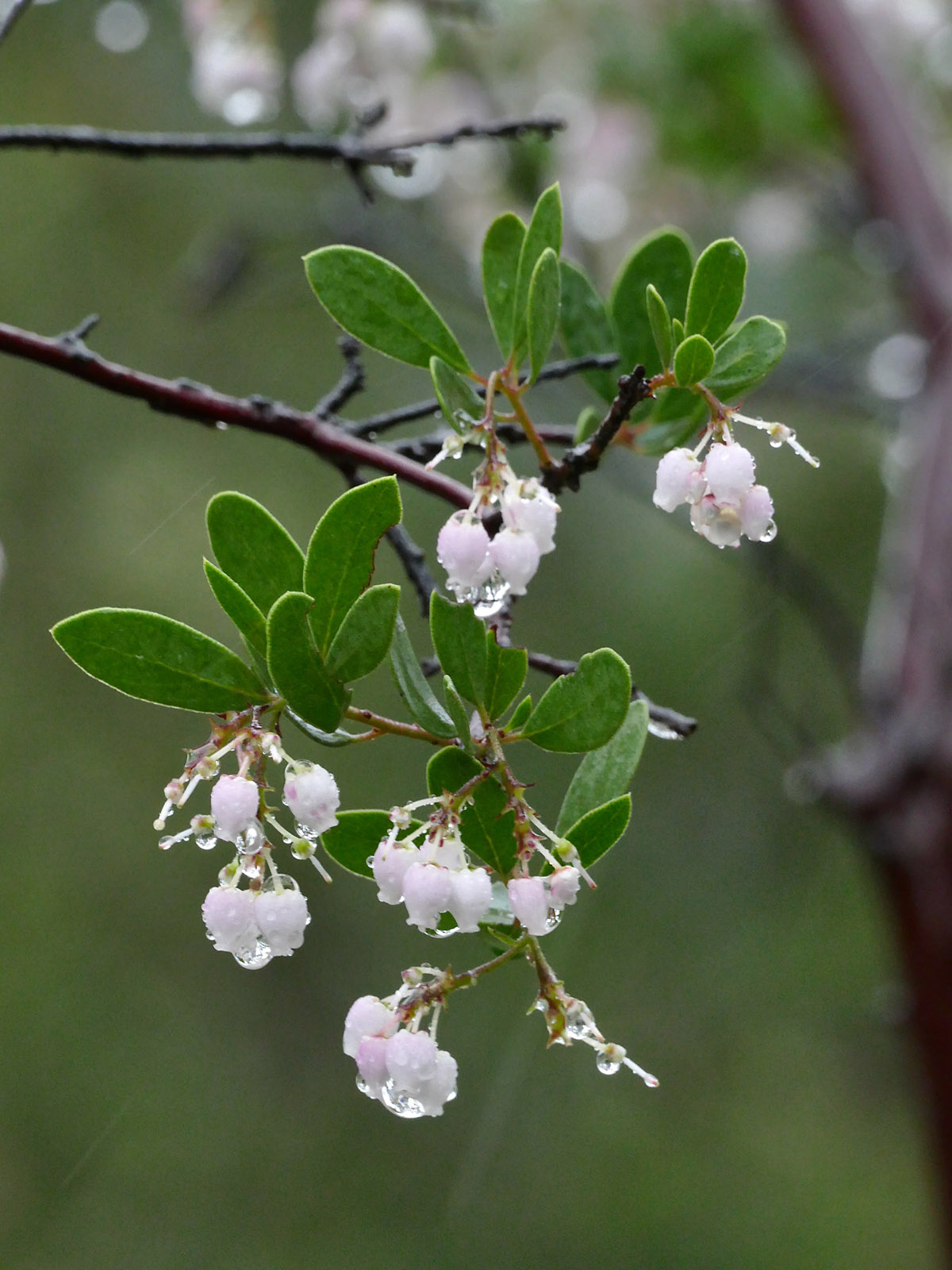
Timing Is Key
In California’s Mediterranean climate, the timing of when you plant and when you water can be critical for plant success. Typically, we consider the planting season to be from about October/November until the end of March, when California experiences its wet season. While some of California’s native plants can be successfully planted/watered in the spring and summer, many, such as oaks (Quercus spp.) will respond poorly to unseasonal planting/watering.
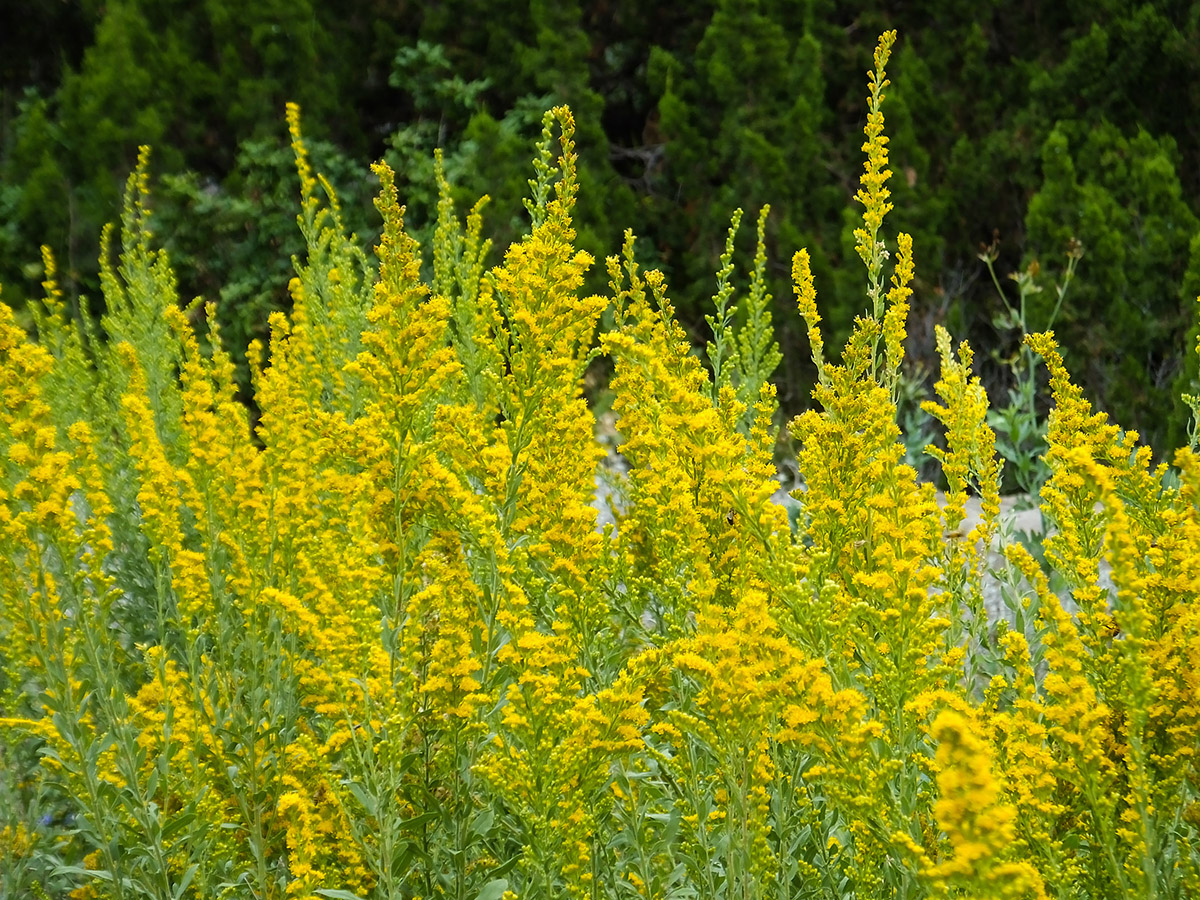
Year-round Interest
California’s flora boasts a diversity of plants that bloom throughout the year. It’s not difficult to select a palette that ensures colorful displays at any time. It’s also possible to select plants with interesting seasonal foliage, fruits, and other characteristics that provide attractive features for people and wildlife throughout the year.
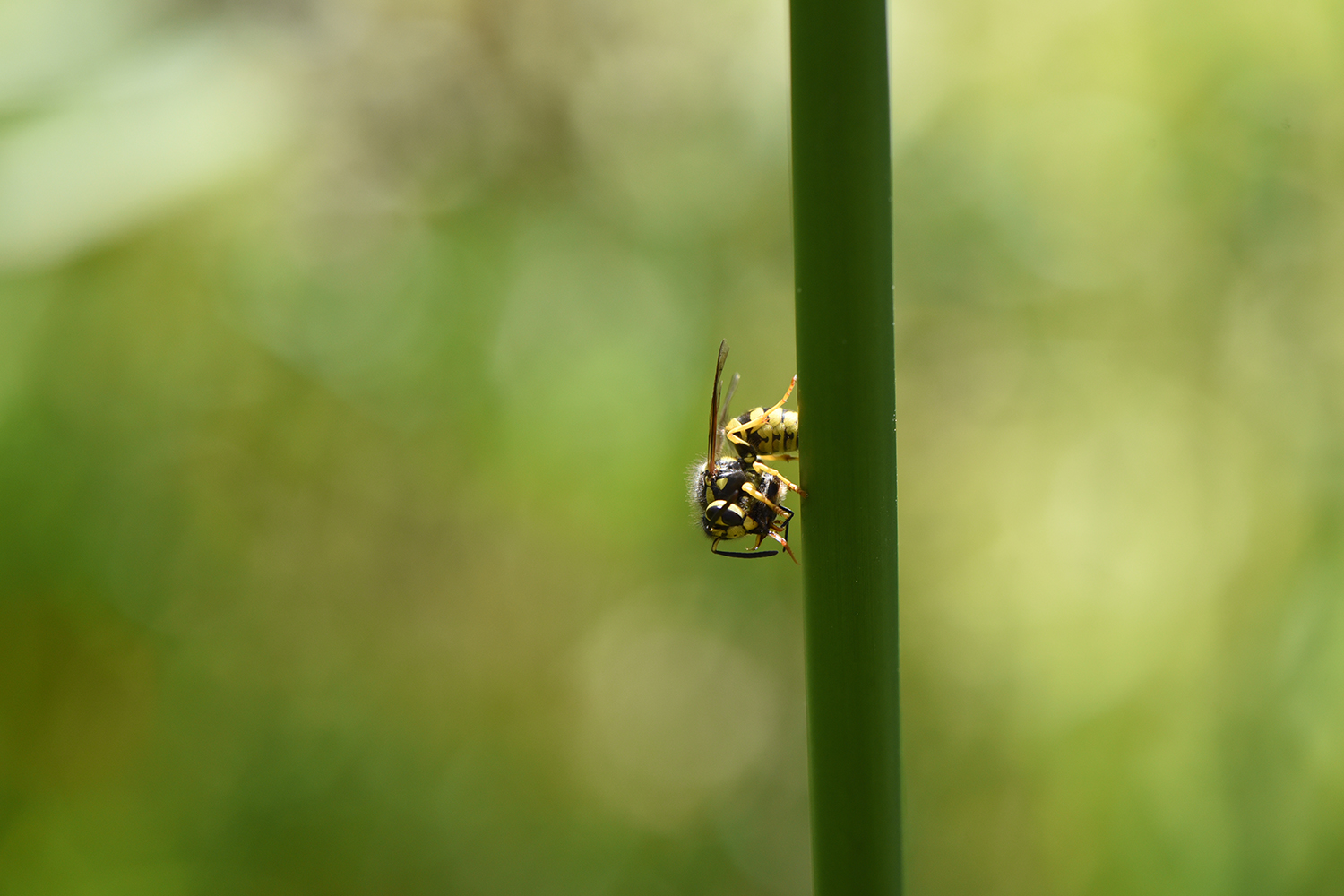
Creatures Great & Small
One of the greatest benefits of using native plants in your garden is that they attract local wildlife. While this may mean that a variety of birds, lizards, and other large wildlife are attracted to your garden, you will most likely notice that bees, butterflies, and beneficial insects such as ladybugs and mantises start to appear.
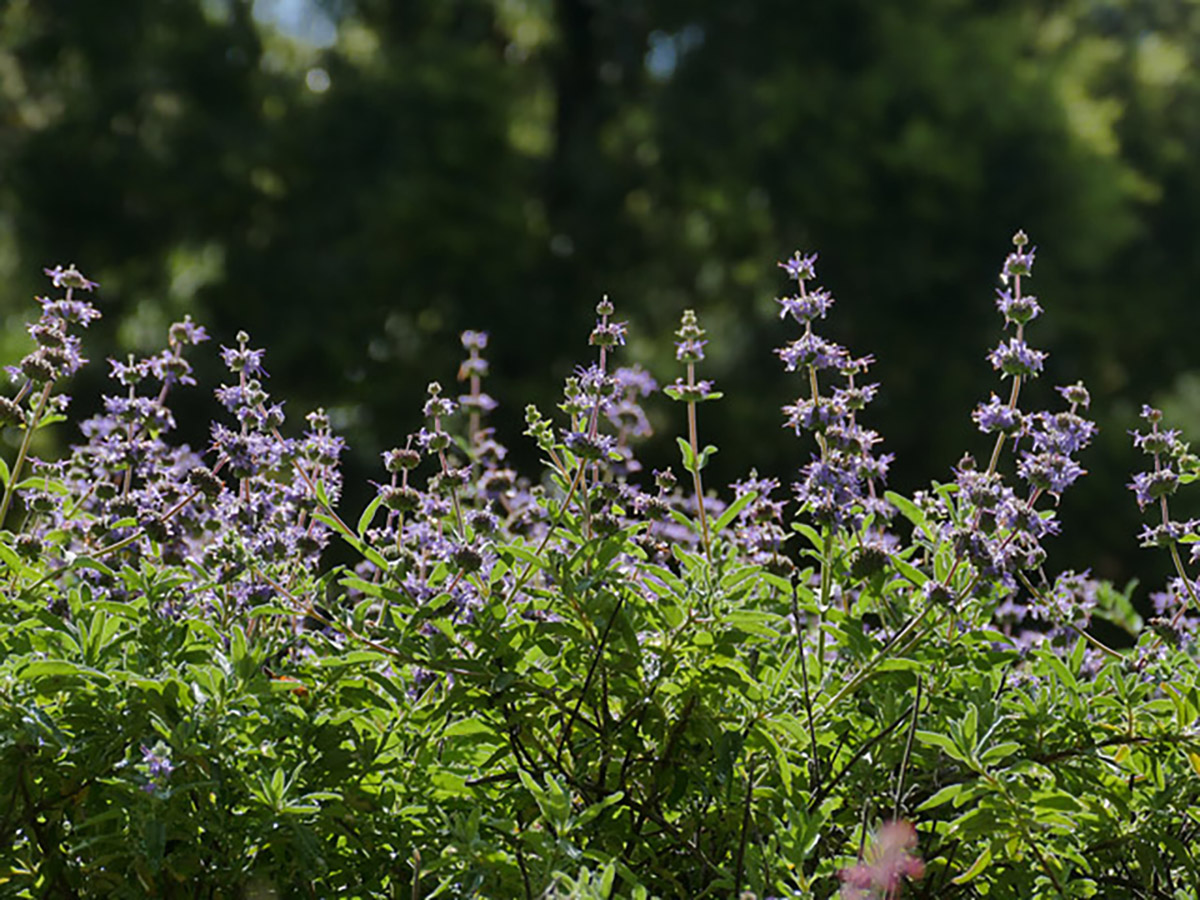
Layers of Habitat
Think about designing your garden in terms of layers: ground plane, mid-story, and canopy. This will add visual interest to your design and provide better habitat. For the ground plane, think about low-growing annuals and perennials. Mid-story plants include shrubs and small trees, while the canopy will consist of larger trees.
Seasonality
When To Plant Is as Important as What To Plant
Many native plants are adapted to a Mediterranean climate, with hot, dry summers and cool, wet winters. This basically means that summertime in California is like wintertime in the rest of the world: a time when plants take it easy and get ready for the harsh times ahead. Of course, many native plants thrive and even flower in the harshest time of the year, but understanding this adaptation is key to growing many of California’s native plants.
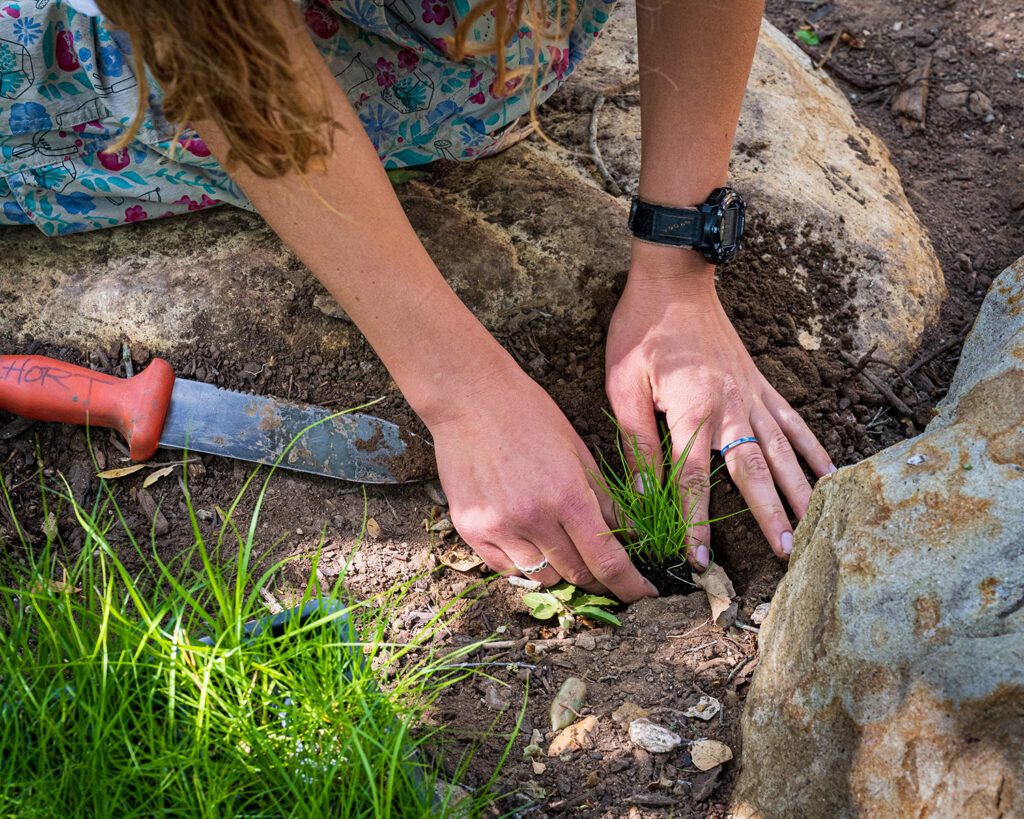
Blooming Calendar
A well-designed native plant garden has something happening every month of the year. Select a month to see a few examples of what is in bloom in a native plant garden throughout the year. Although most flowering plants attract some wildlife, we’ve highlighted the ones that the critters seem to really enjoy.
Seasonal Listings
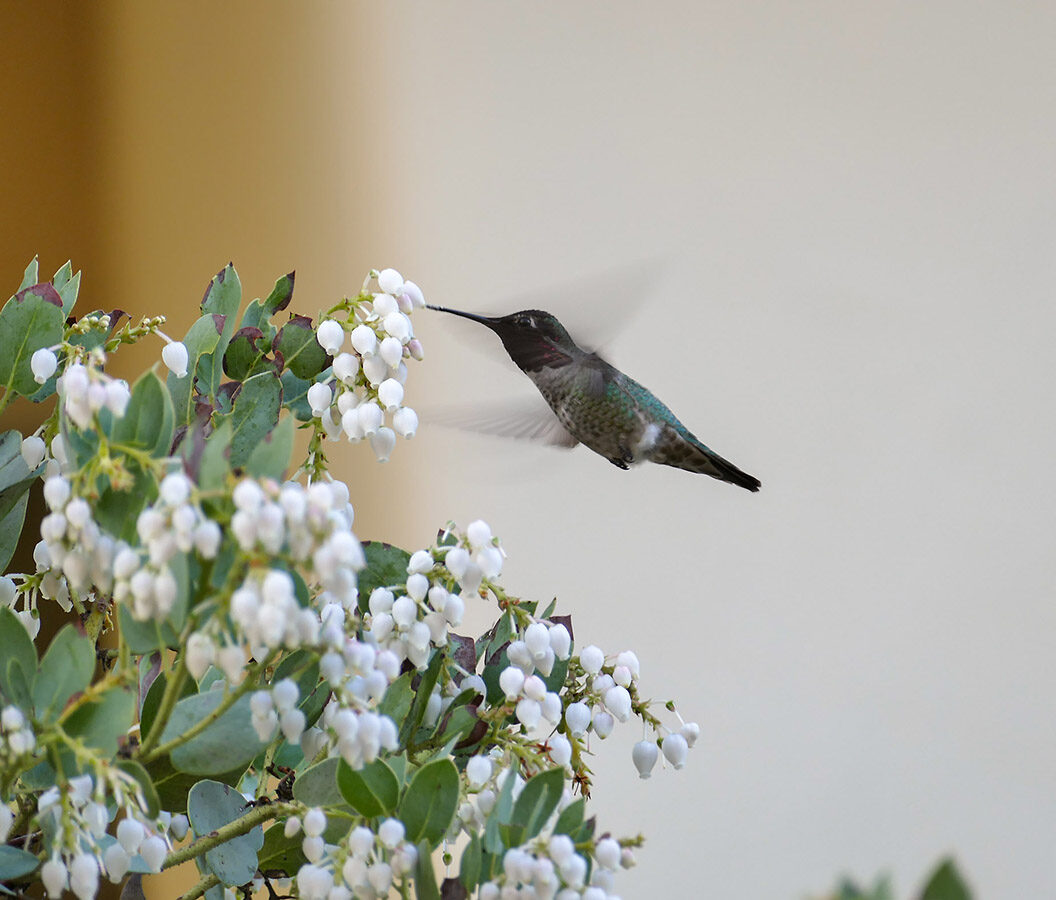
Hummingbird feeding on bigberry manzanita (Arctostaphylos glauca) (Photo: Randy Wright)
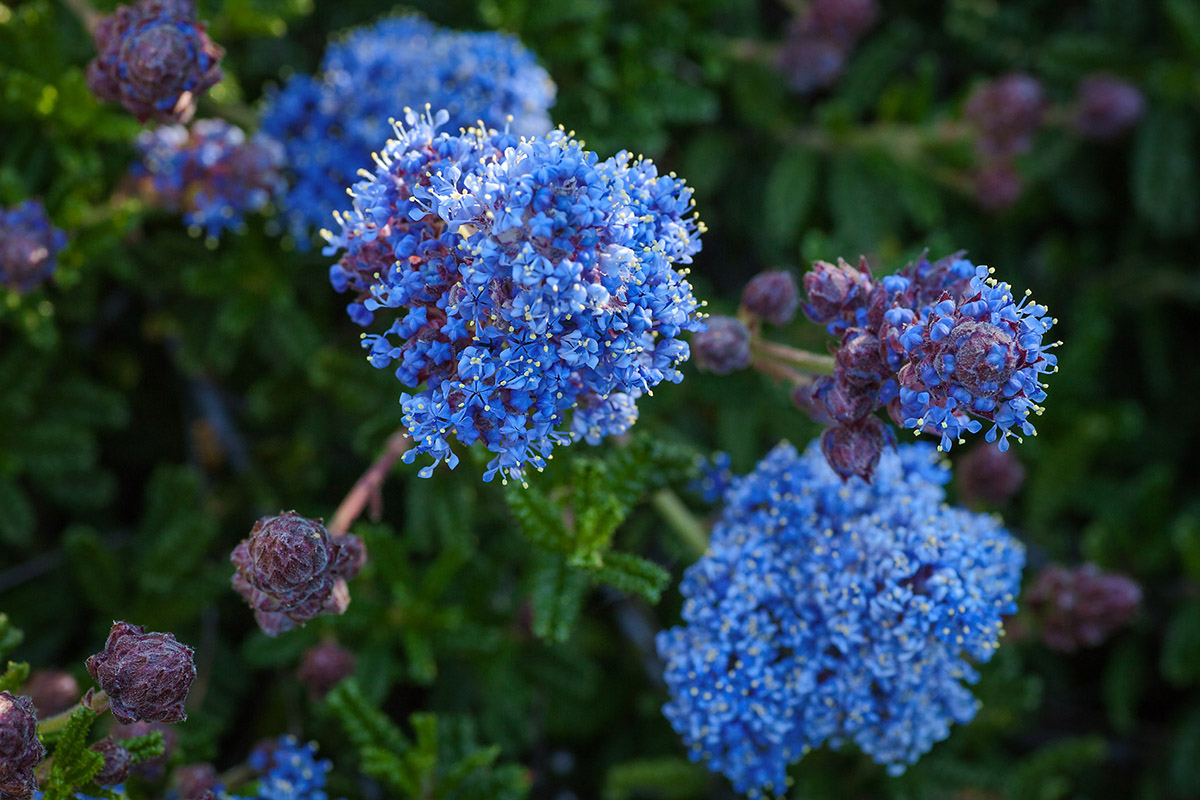
California lilac (Ceanothus) (Photo: Denise Dewire)
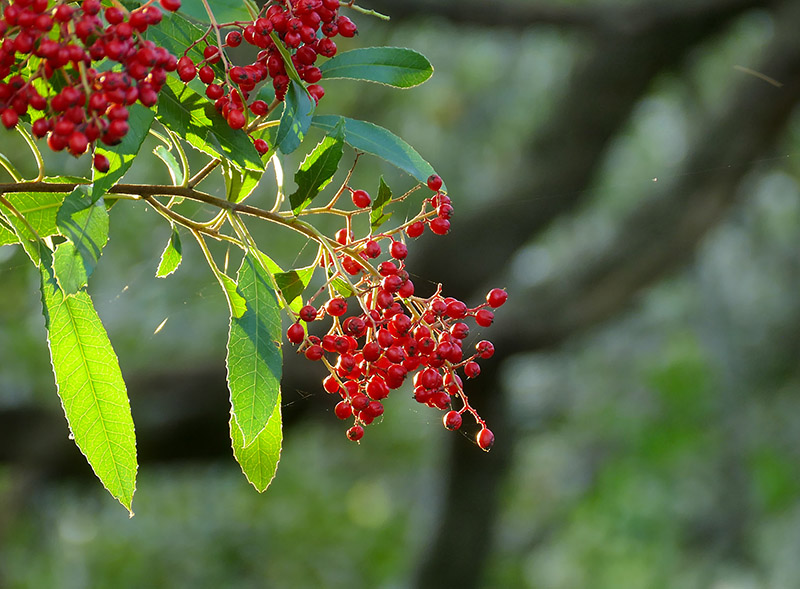
Toyon (Heteromeles arbutifolia) berries (Photo: Randy Wright)
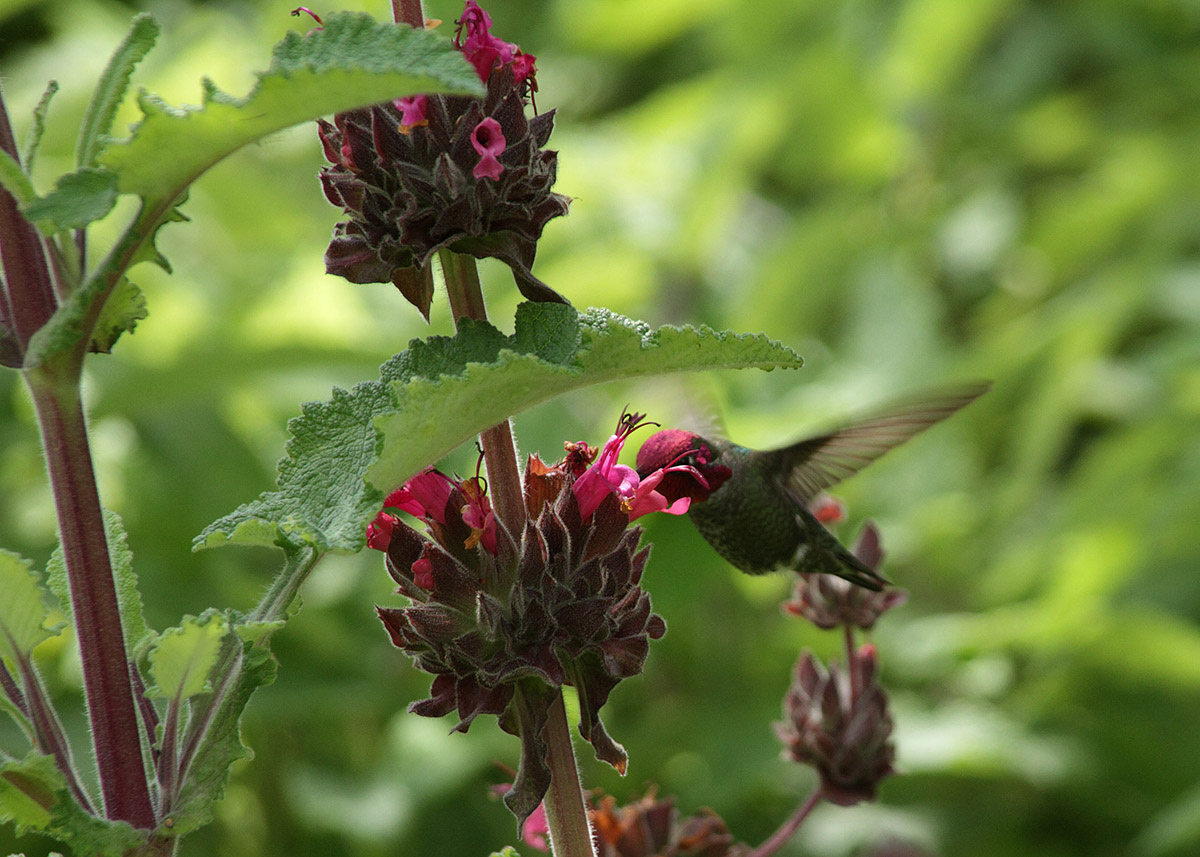
Hummingbird visiting hummingbird sage (Salvia spathacea) (Photo: Lynn Watson)
January
Manzanitas (Arctostaphylos spp.)
Attracts bumblebees, hummingbirds
California lilacs (Ceanothus spp.)
Attracts butterflies, native bees
Toyon (Heteromeles arbutifolia)
Brilliant red berries, attracts birds
Hummingbird sage (Salvia spathacea)
Attracts hummingbirds
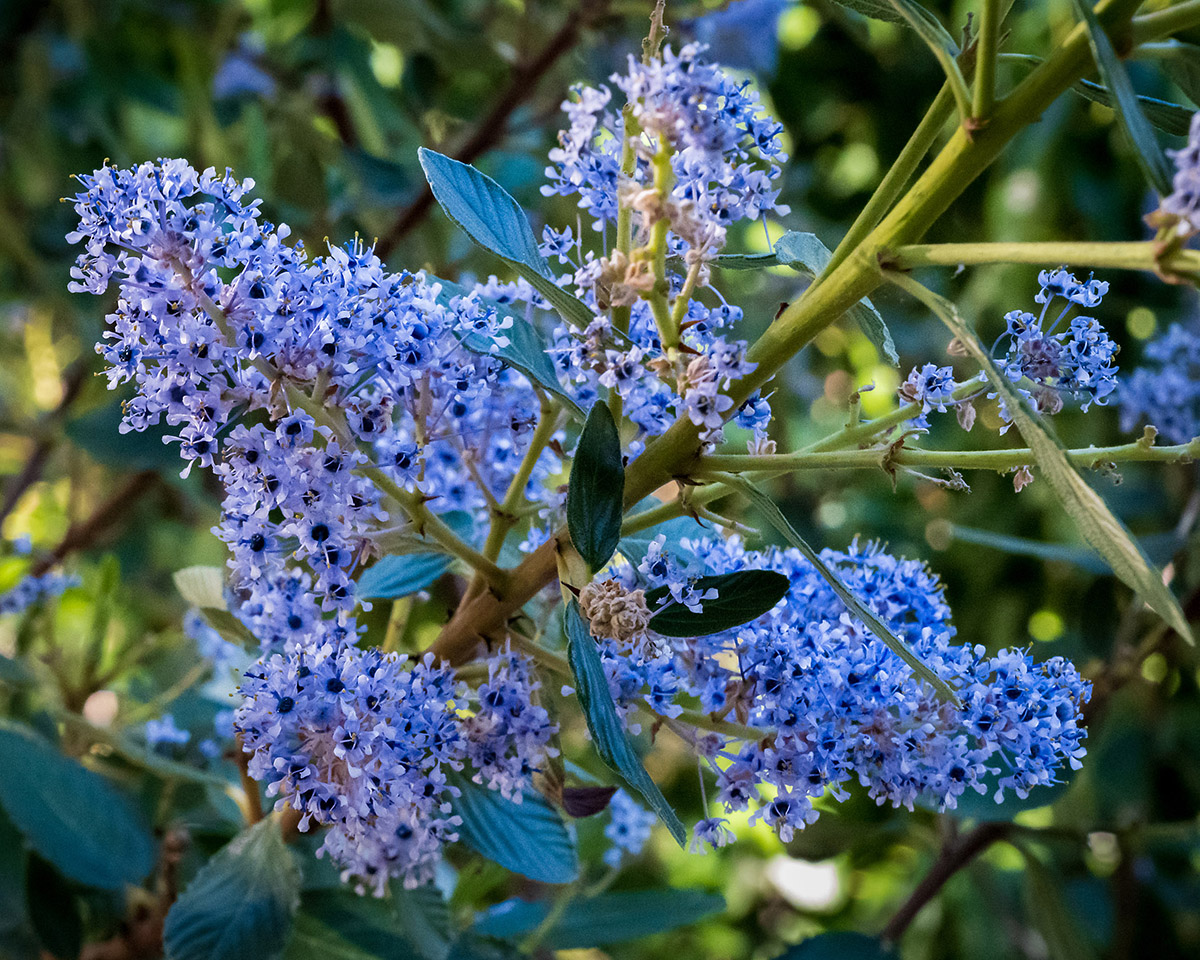
California lilac (Ceanothus) (Photo: Greg Trainor)
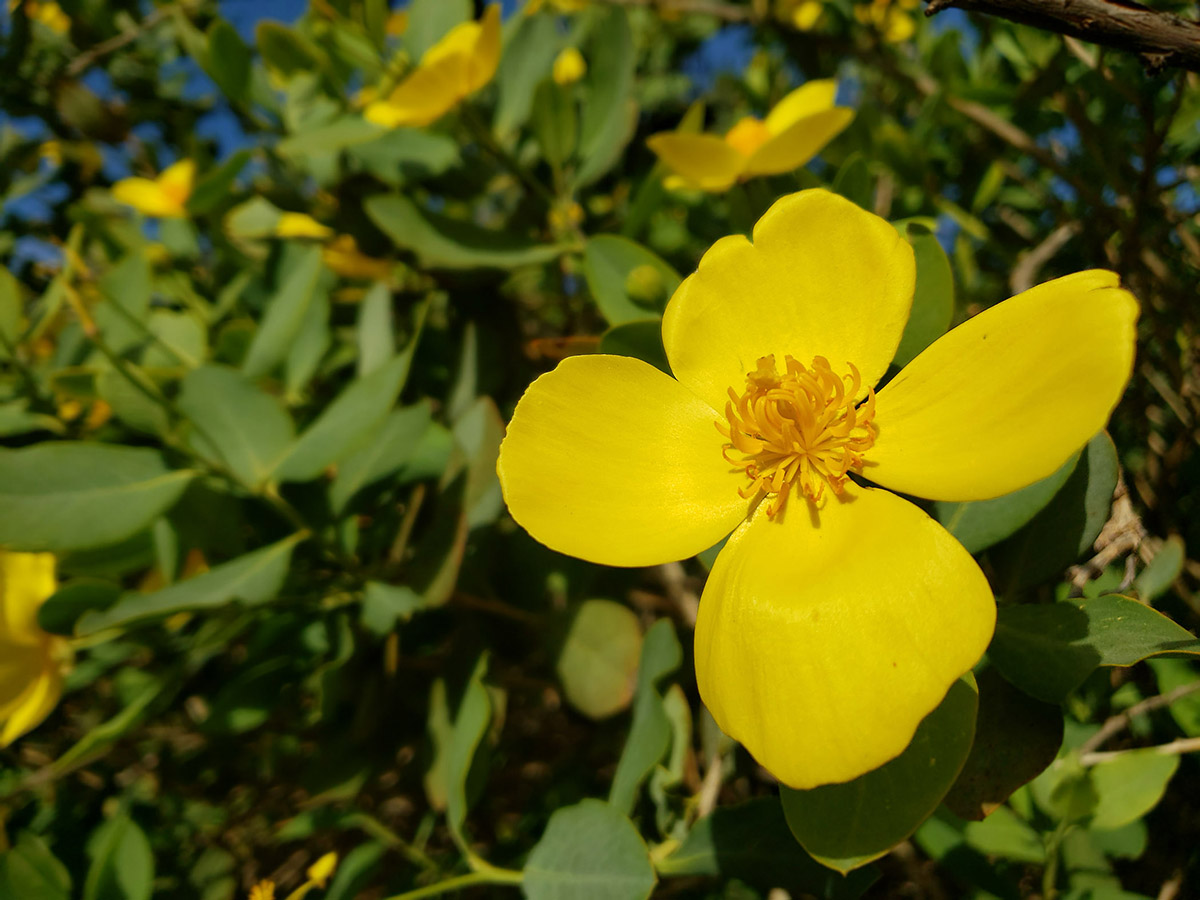
Bush poppy (Dendromecon rigida) (Photo: Michelle Cyr)
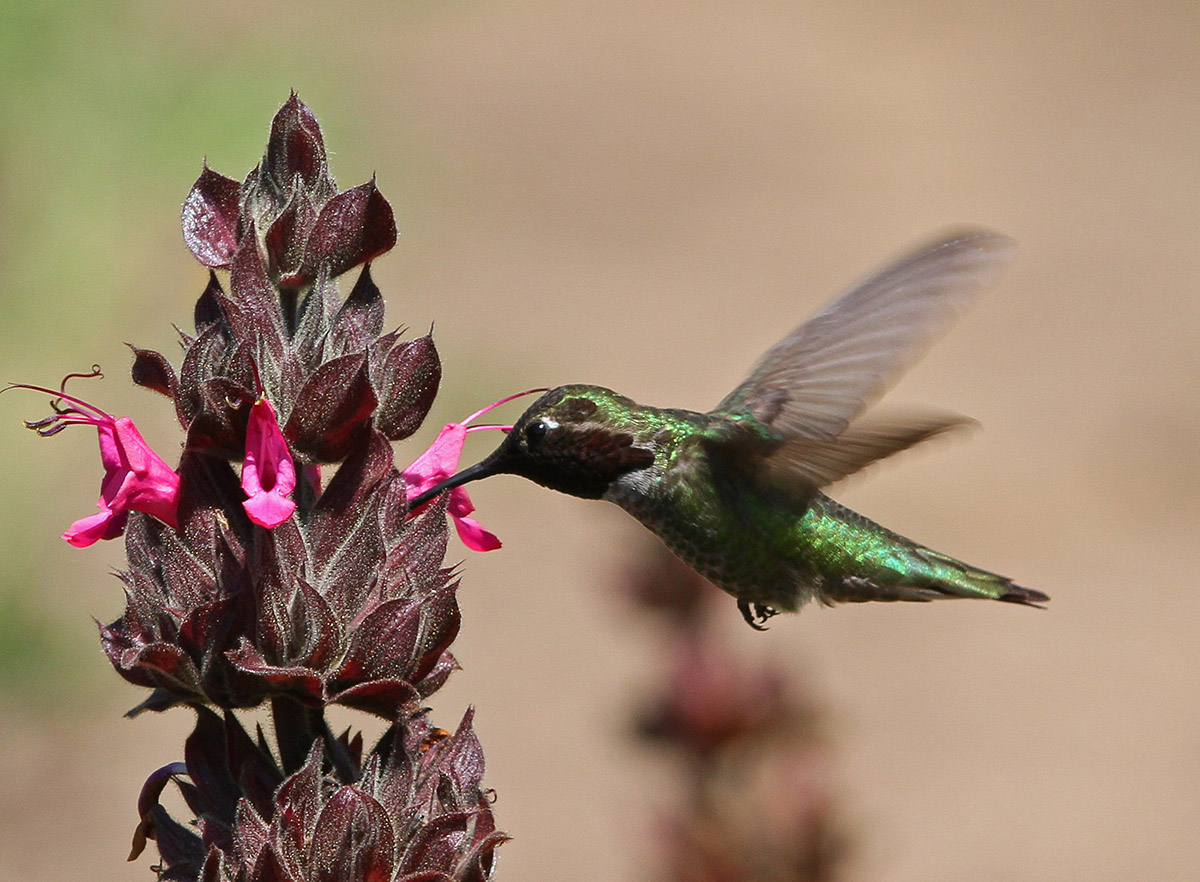
Hummingbird and hummingbird sage (Salvia spathacea) (Photo: Daryl Metzger)
February
California lilacs (Ceanothus spp.)
Attracts butterflies, bees
Bush poppy (Dendromecon rigida)
Attracts butterflies, bees
Hummingbird sage (Salvia spathacea)
Attracts hummingbirds
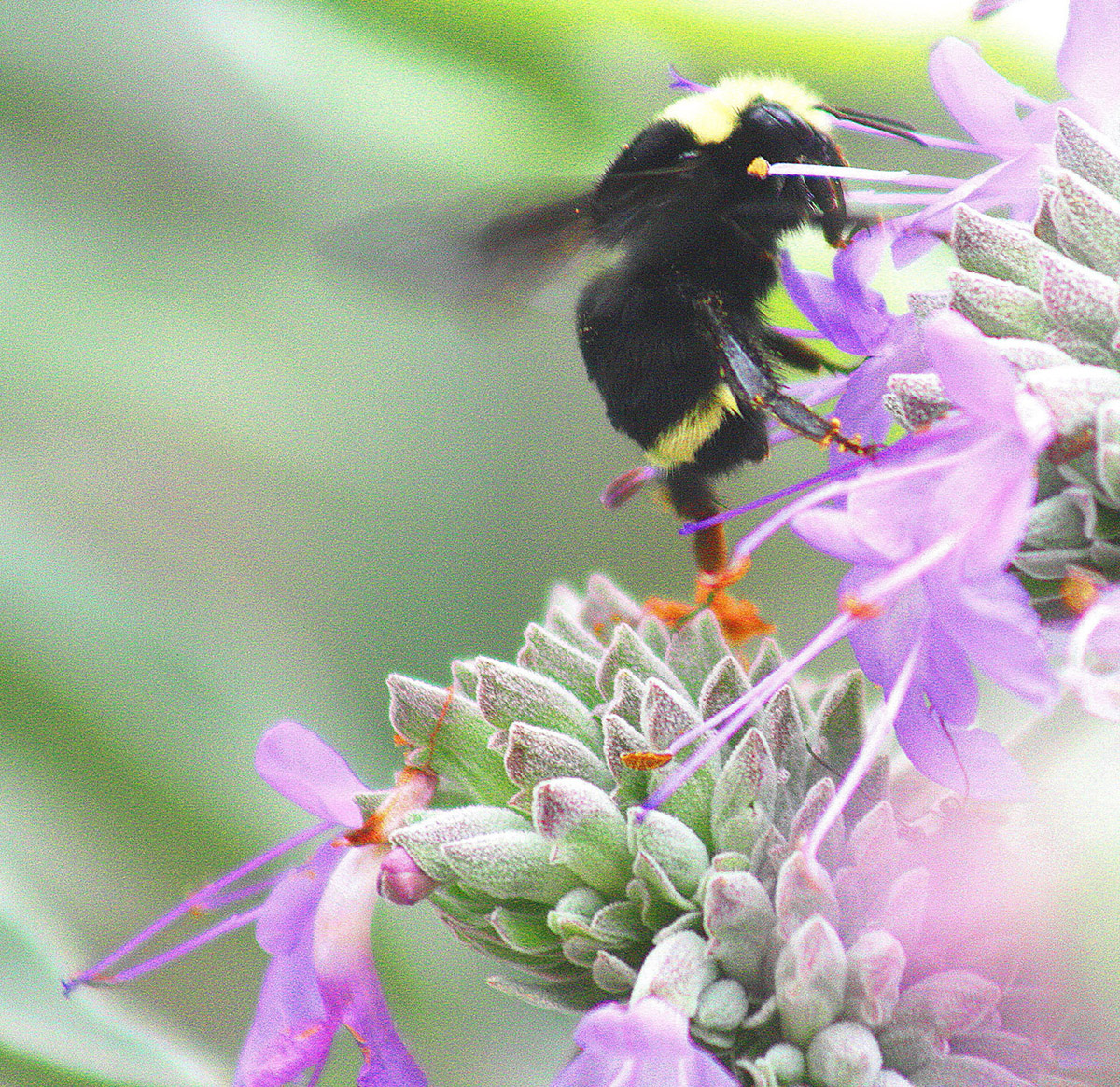
Bumblebee on purple sage (Salvia) (Photo: Robin Oaks)
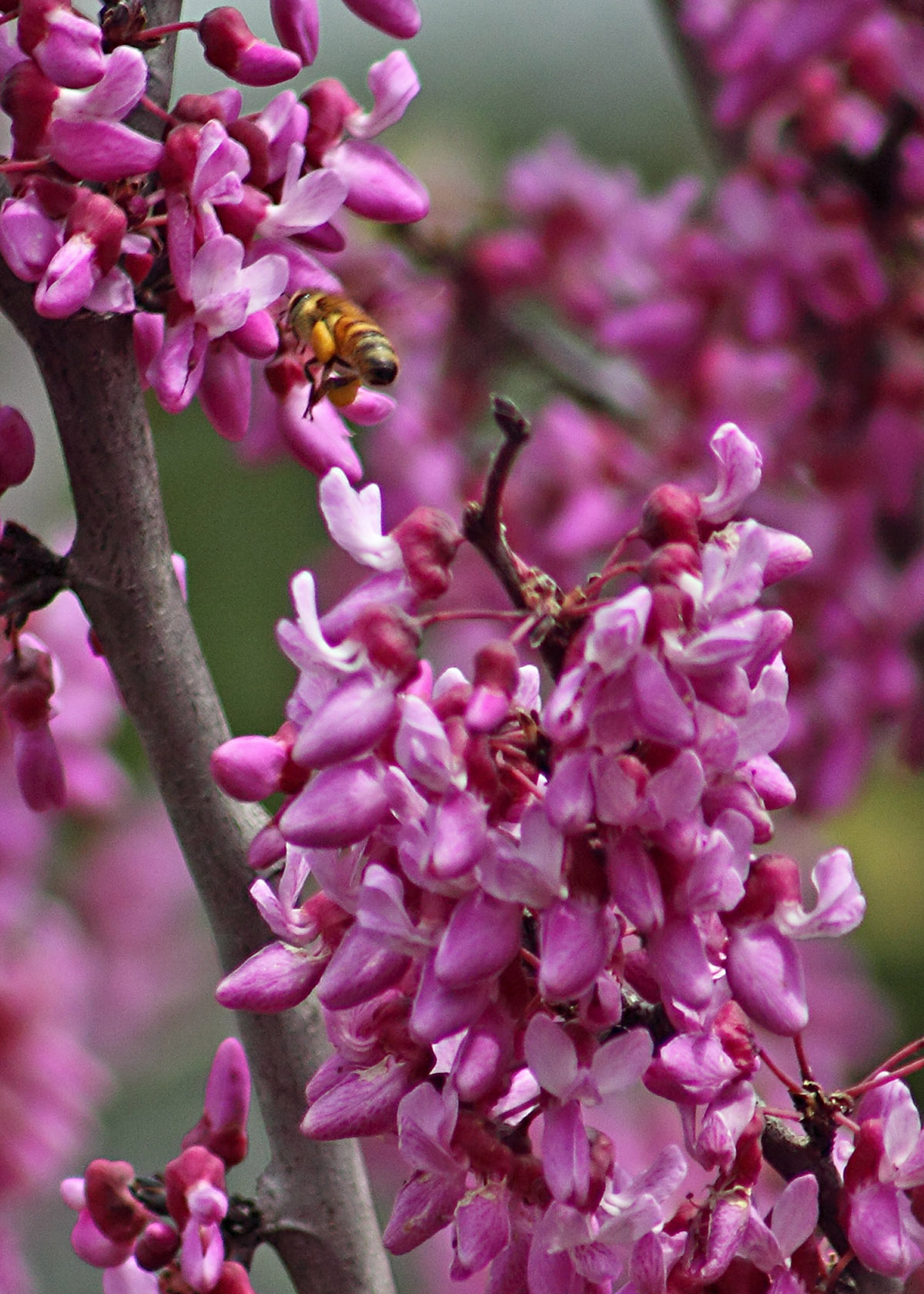
Honeybee on western redbud (Cercis occidentalis) in bloom (Photo: Michael Horns)
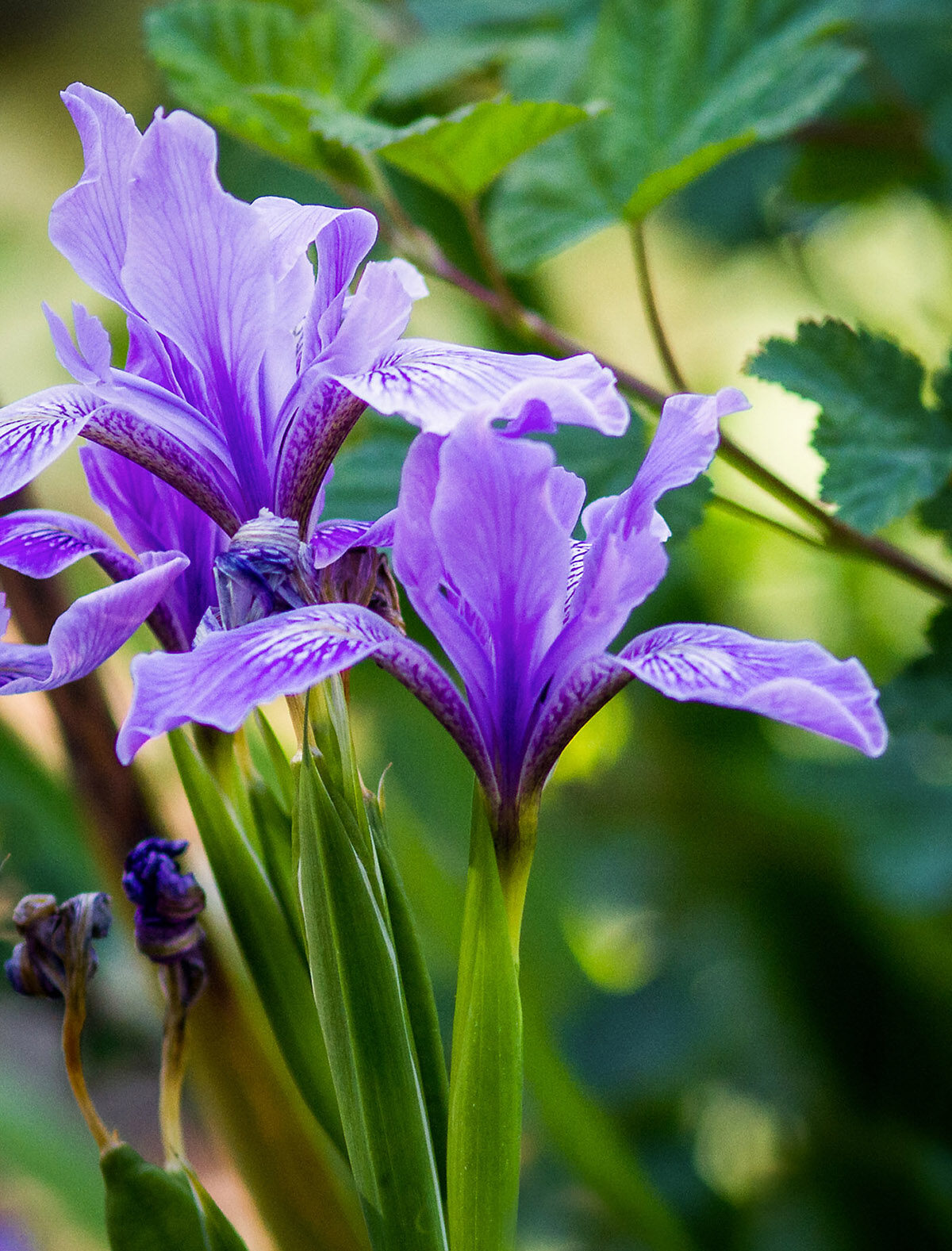
Iris (Iris) blooming (Photo: Denise Dewire)
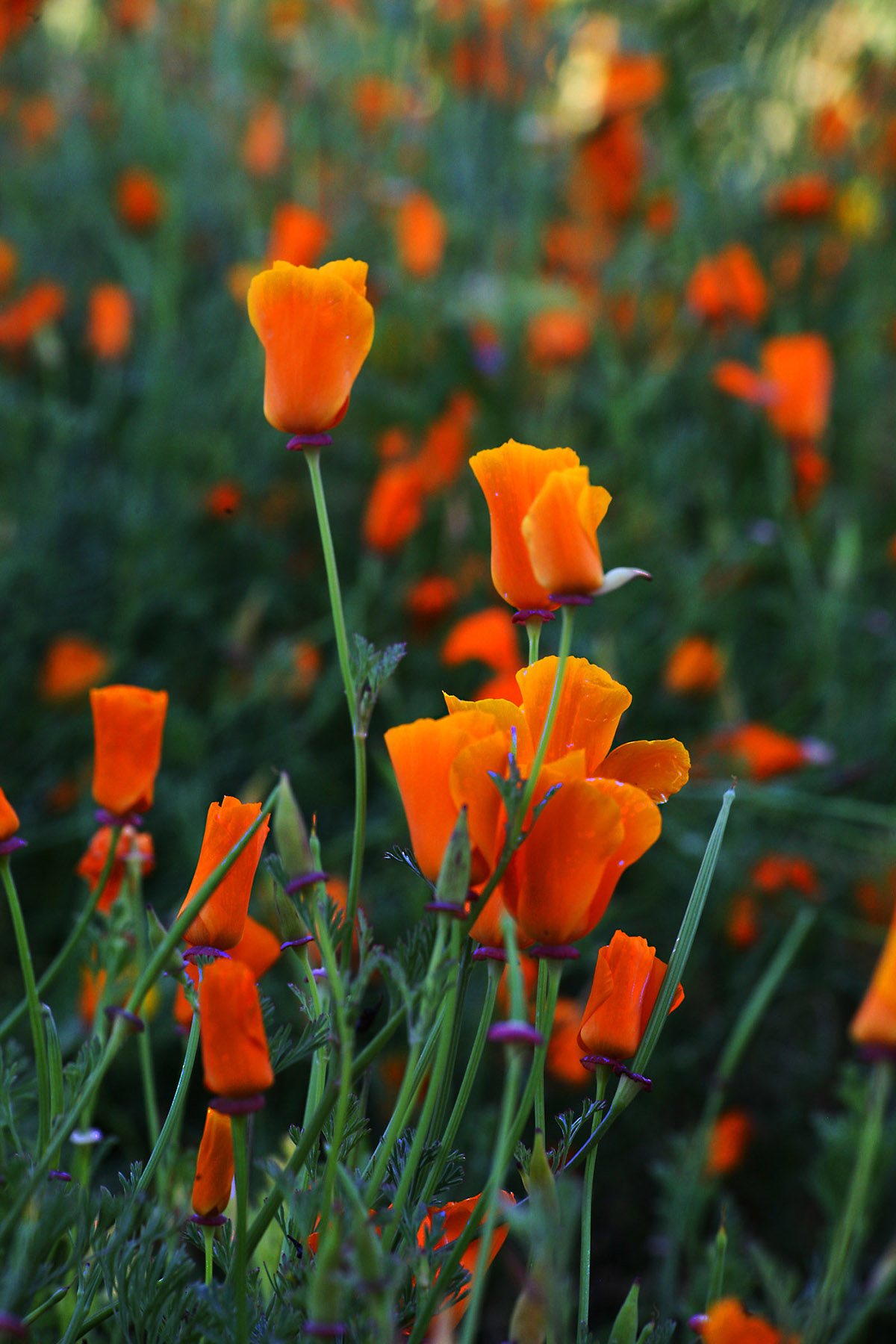
California poppy (Eschscholzia californica) in the Meadow Section (Photo: Stacy Bloodworth)
March
Black, white, and purple sages (Salvia spp.)
Attracts butterflies, bees
California lilacs (Ceanothus spp.)
Attracts butterflies, bees
Western redbud (Cercis occidentalis)
Irises (Iris spp.)
California poppy (Eschscholzia californica)
Lupines (Lupinus spp.)
Attracts bumblebees
Coral bells (Heuchera)
Monkeyflowers (Diplacus spp.)
Yarrow (Achillea millefolium)
Lemonade berry (Rhus integrifolia)
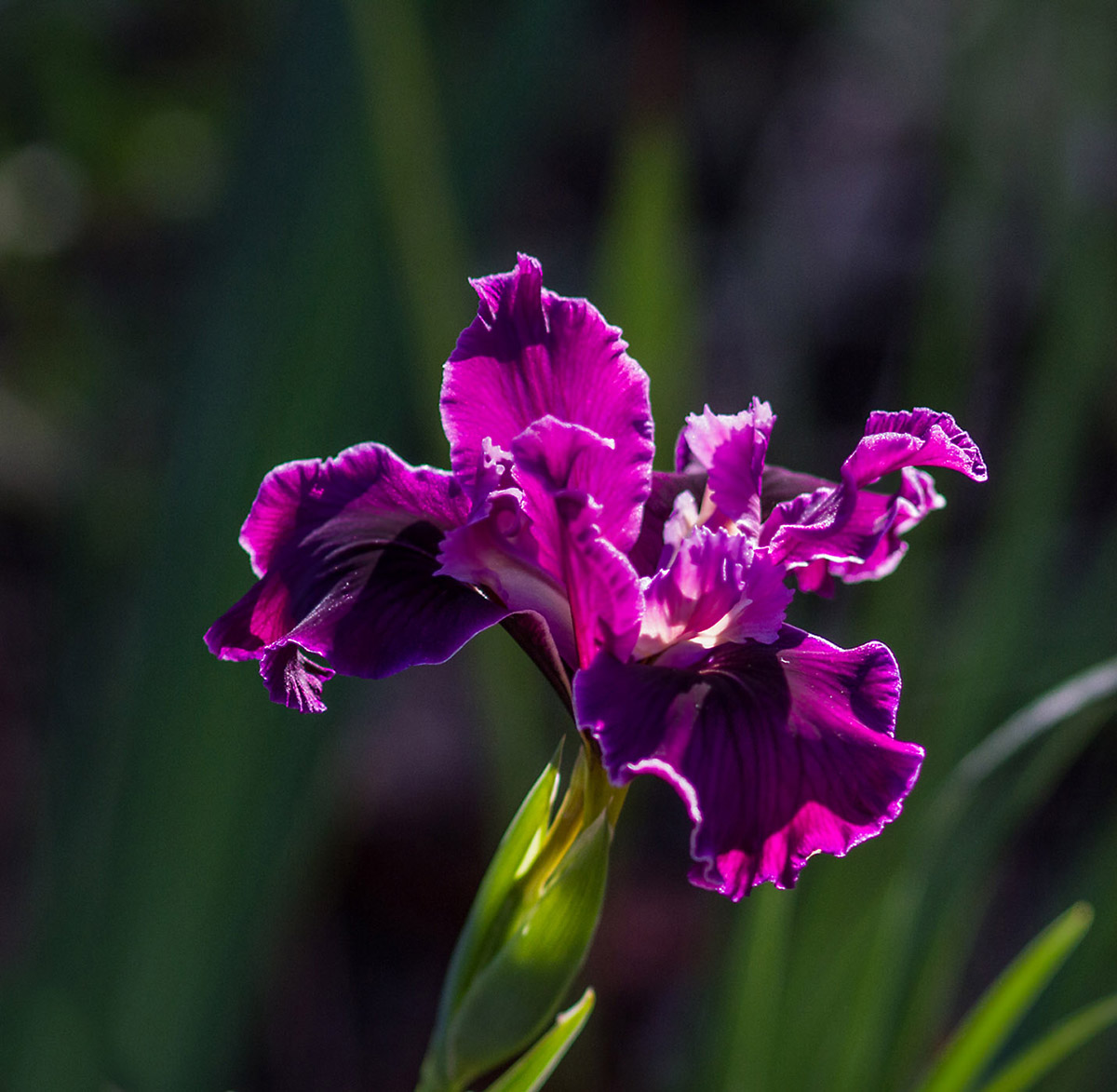
Iris (Iris) (Photo: Denise Dewire)
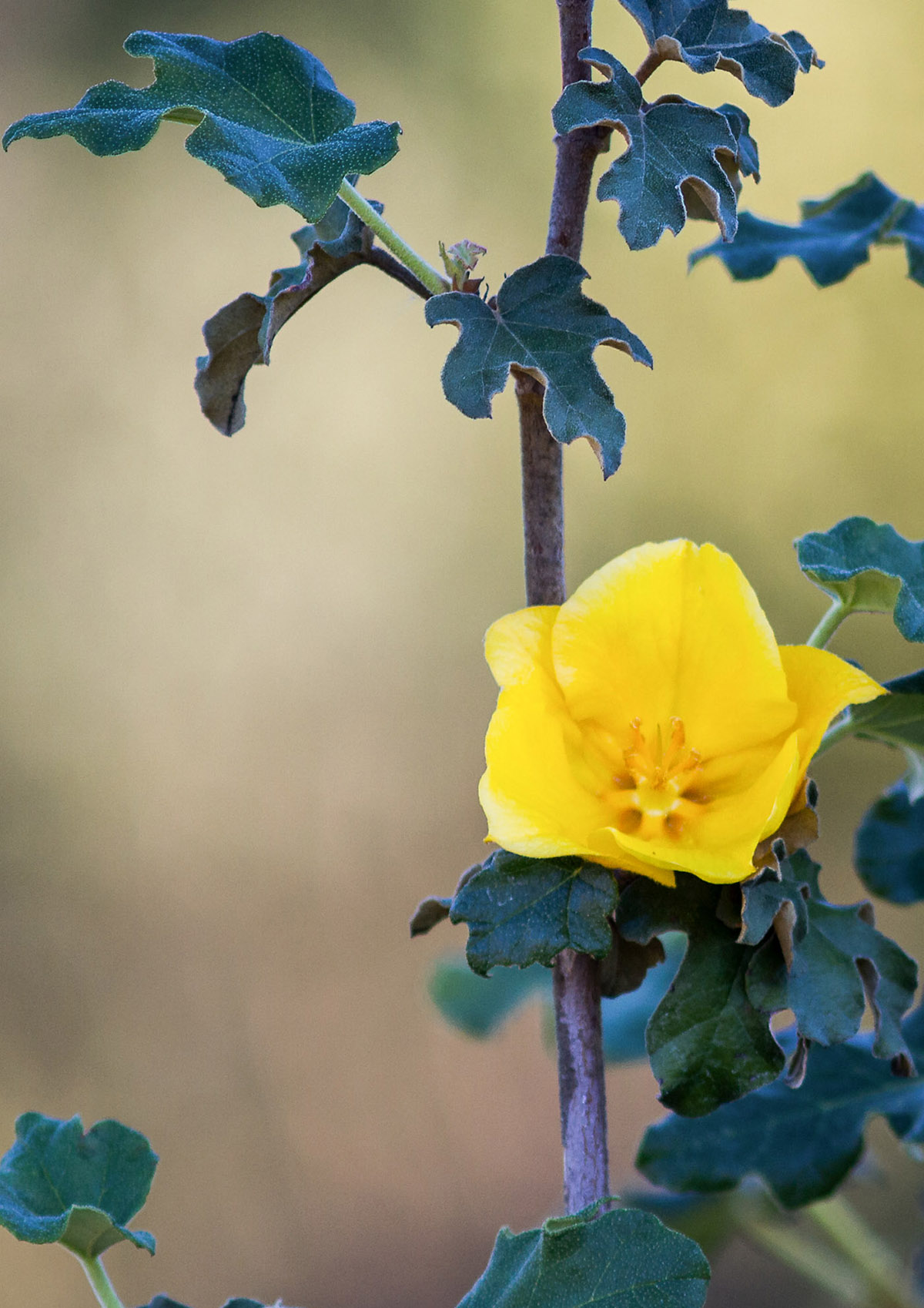
Flannel bush (Fremontodendron californicum) (Photo: Denise Dewire)
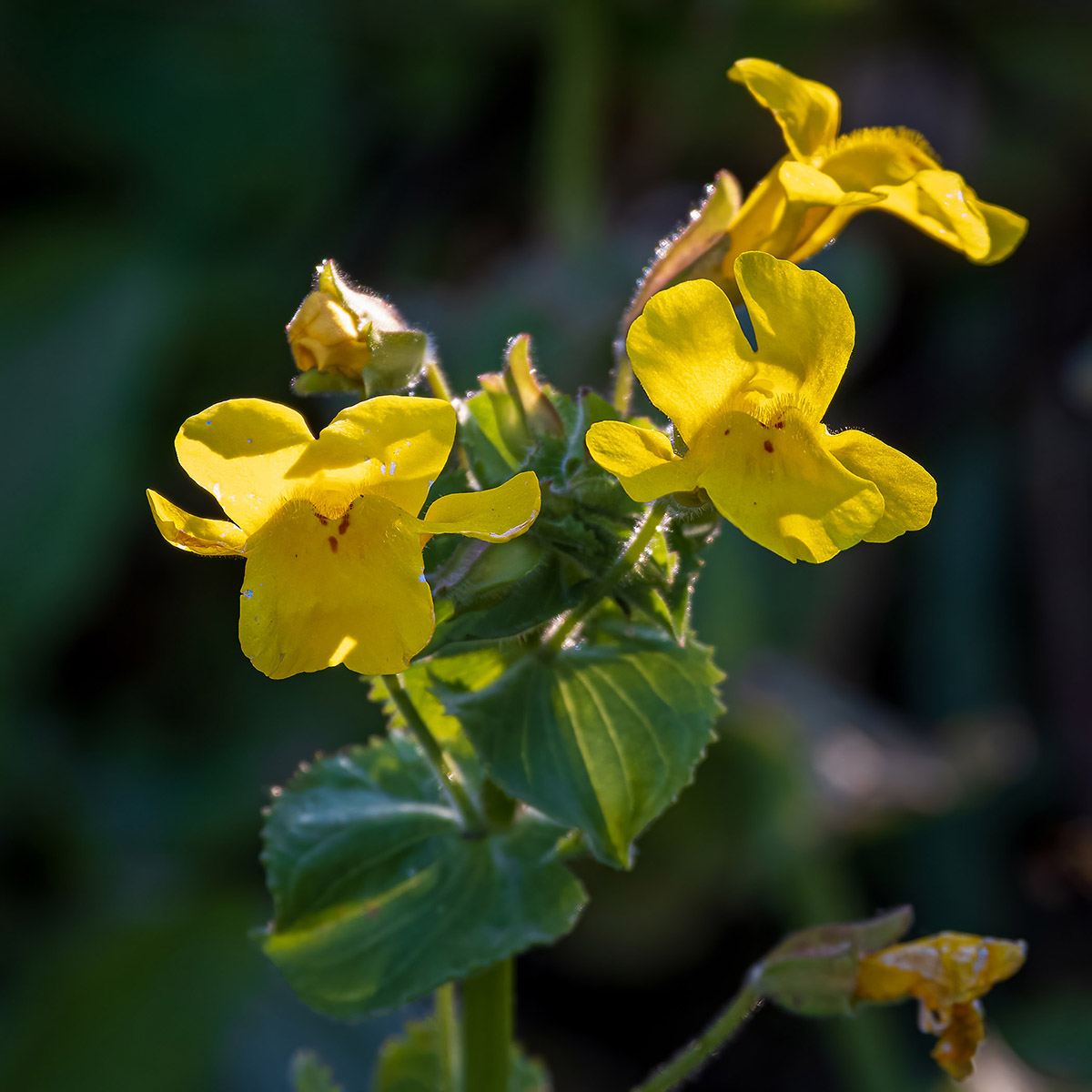
Monkeyflower (Diplacus) (Photo: Greg Trainor)
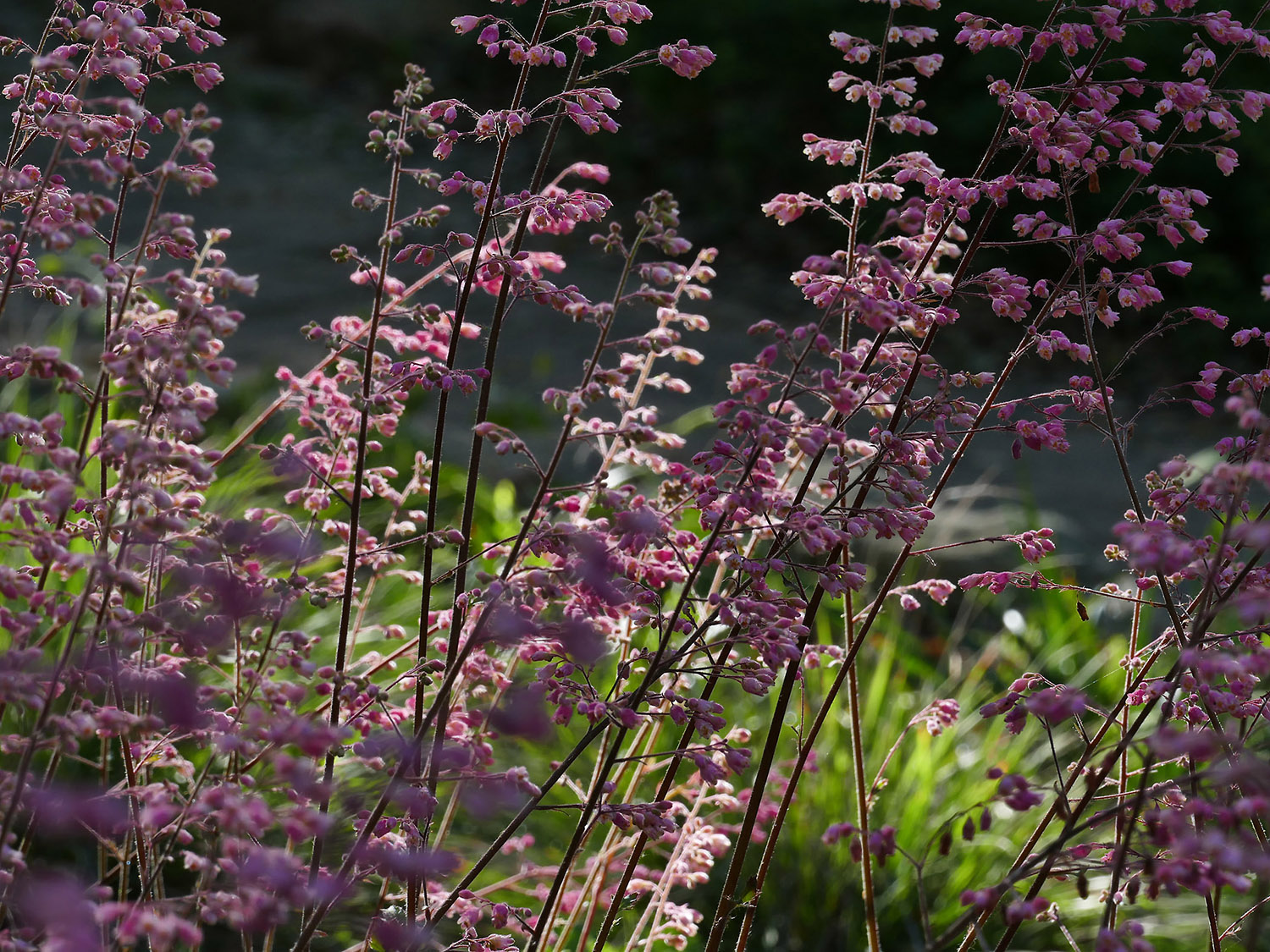
Coral bells (Heuchera) in the Wooded Dell Section (Photo: Randy Wright)
April
Irises (Iris spp.)
Flannel bush (Fremontodendron californicum)
Monkeyflowers (Diplacus spp.)
Bloom April into summer
Coral bells (Heuchera)
Black, white, and purple sages (Salvia spp.)
Attracts butterflies, bees
California lilacs (Ceanothus spp.)
Attracts butterflies, bees
California poppy (Eschscholzia californica)
Lupines (Lupinus spp.)
Attracts bumblebees
Yarrow (Achillea millefolium)
Lemonade berry (Rhus integrifolia)
Bush poppy (Dendromecon rigida)
Many wildflowers: tidy tips (Layia platyglossa), farewell to spring (Clarkia), baby blue eyes (Nemophila menziesii), bicolor lupine (Lupinus bicolor), chia (Salvia columbaria)

Hairy matilija poppy (Romnea trichocalyx) (Photo: Randy Wright)
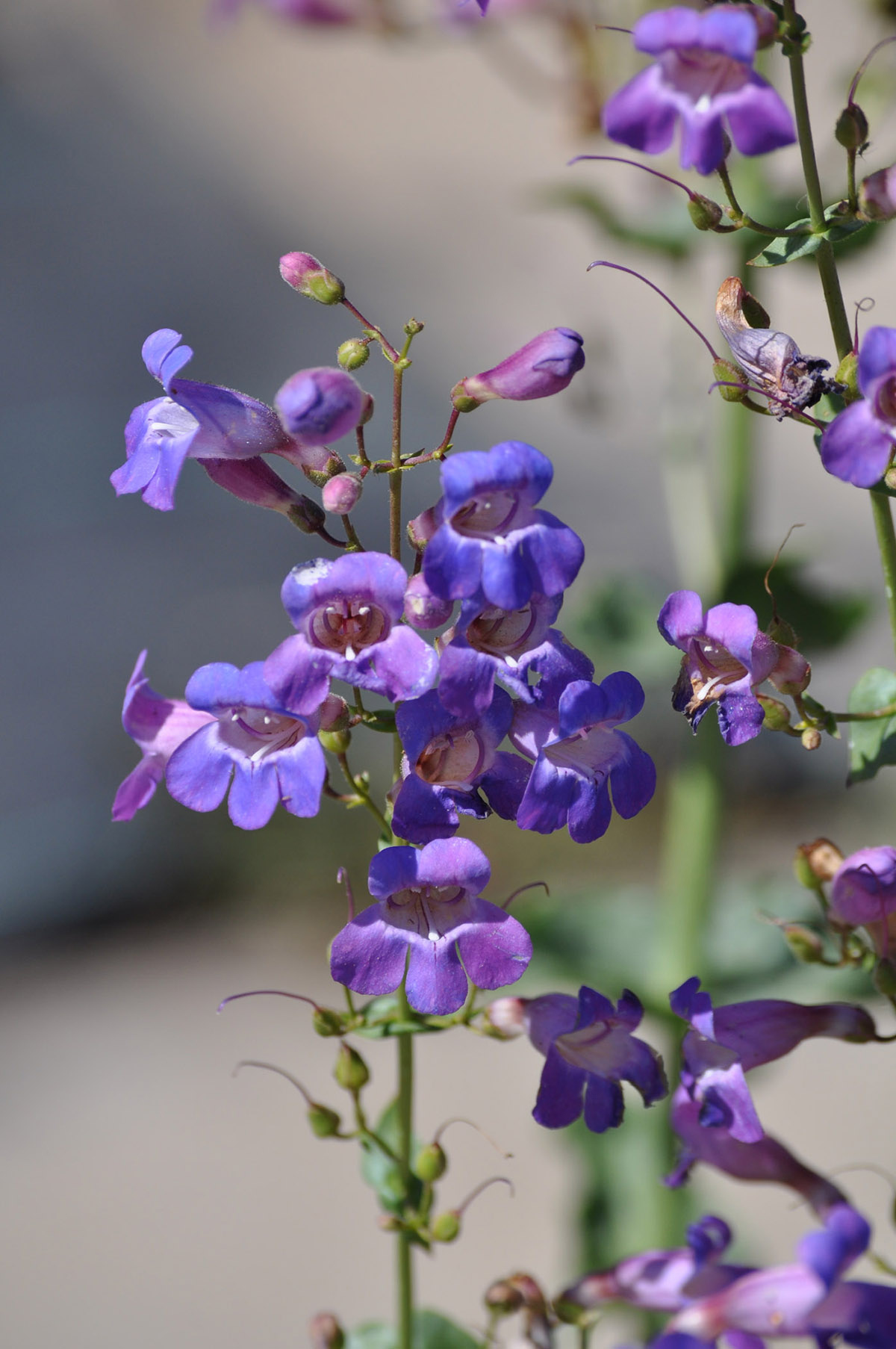
Beardtongue (Penstemon spectabilis) (Photo: Heather Wehnau)
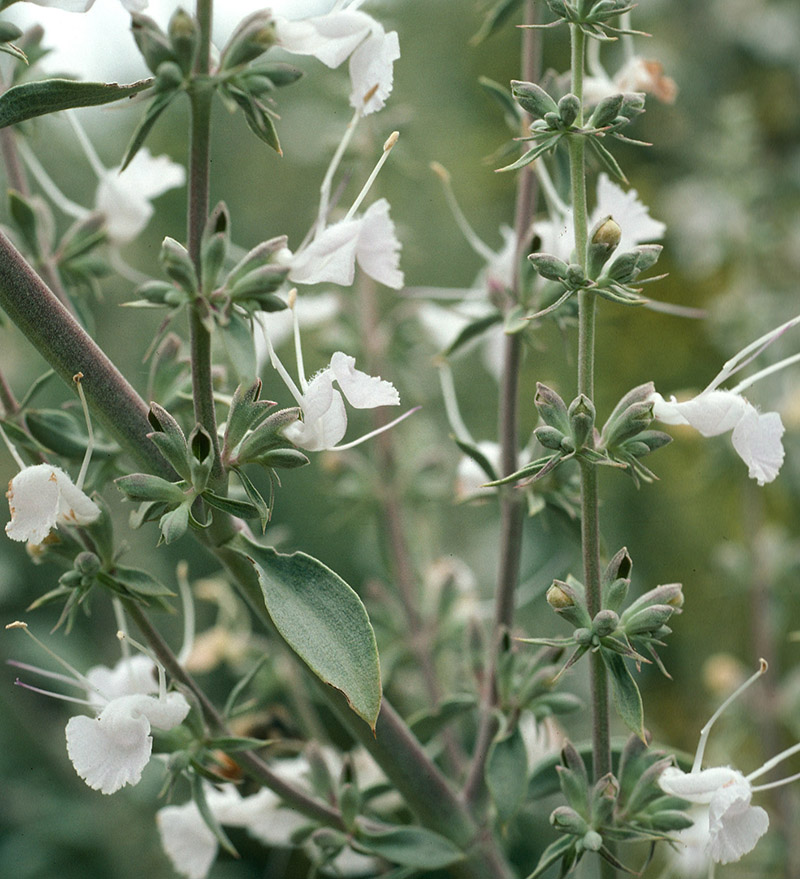
White sage (Salvia apiana) (Photo: Steve Junak)
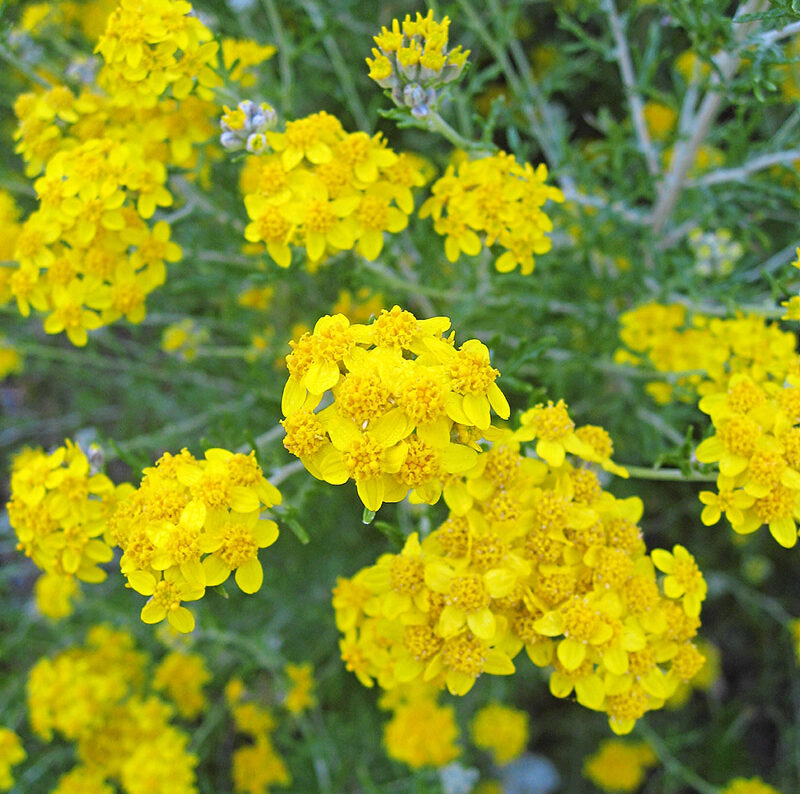
Golden yarrow (Eriophyllum confertiflorum) (Photo: Elizabeth Collins)
May
Matilija poppy (Romneya coulteri)
Beardtongues (Penstemon spp.)
Attracts butterflies, bees
Black, white, and purple sages (Salvia spp.)
Attracts butterflies, bees
Blue eyed grass (Sisyrinchium bellum)
Flannel bush (Fremontodendron californicum)
California poppy (Eschscholzia californica)
Many wildflowers: tidy tips (Layia platyglossa), farewell to spring (Clarkia), baby blue eyes (Nemophila menziesii), bicolor lupine (Lupinus bicolor), chia (Salvia columbaria)
Yarrow (Achillea millefolium)
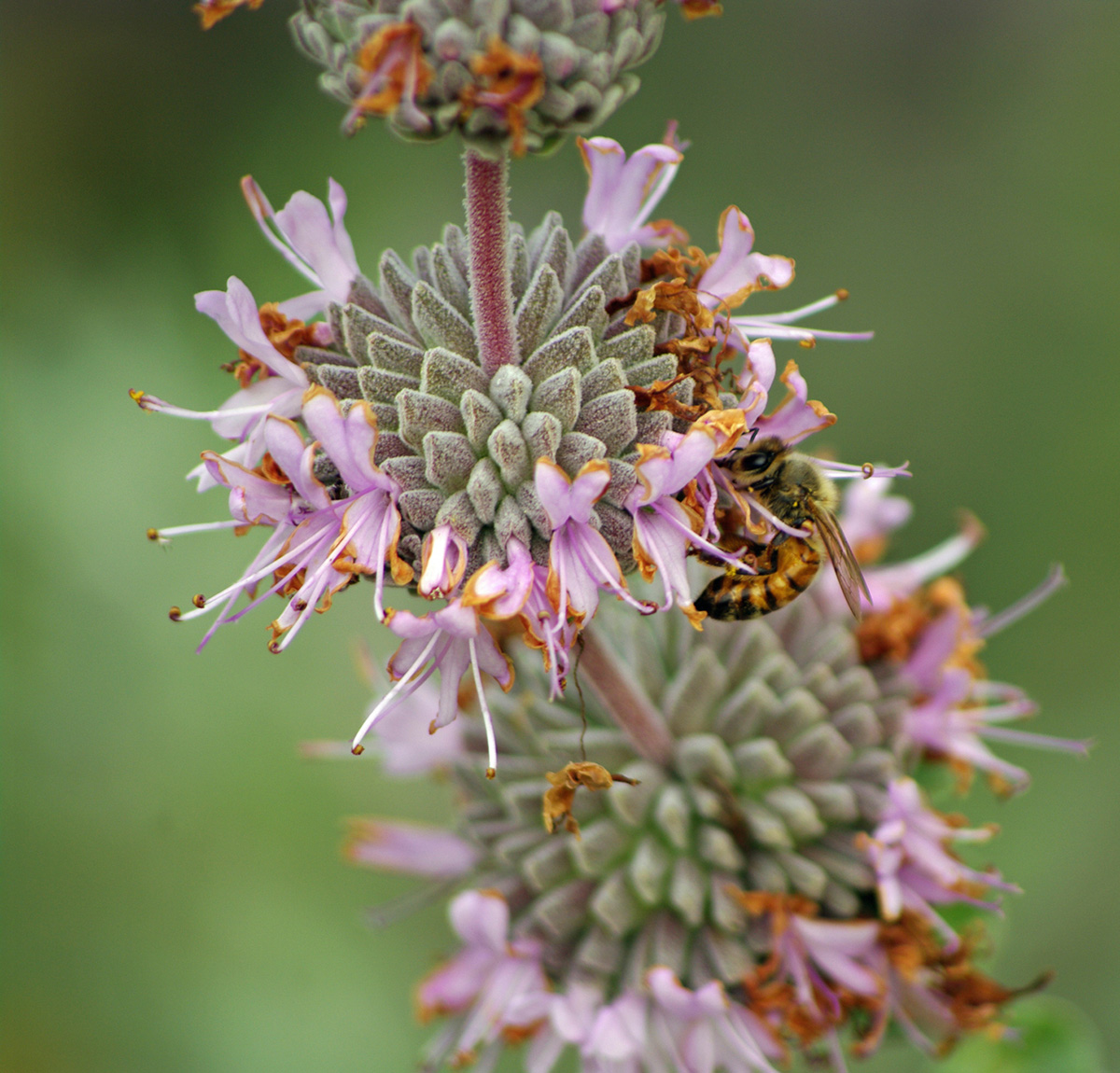
Purple sage (Salvia leucophylla) with honeybee (Photo: Gary Margeson)
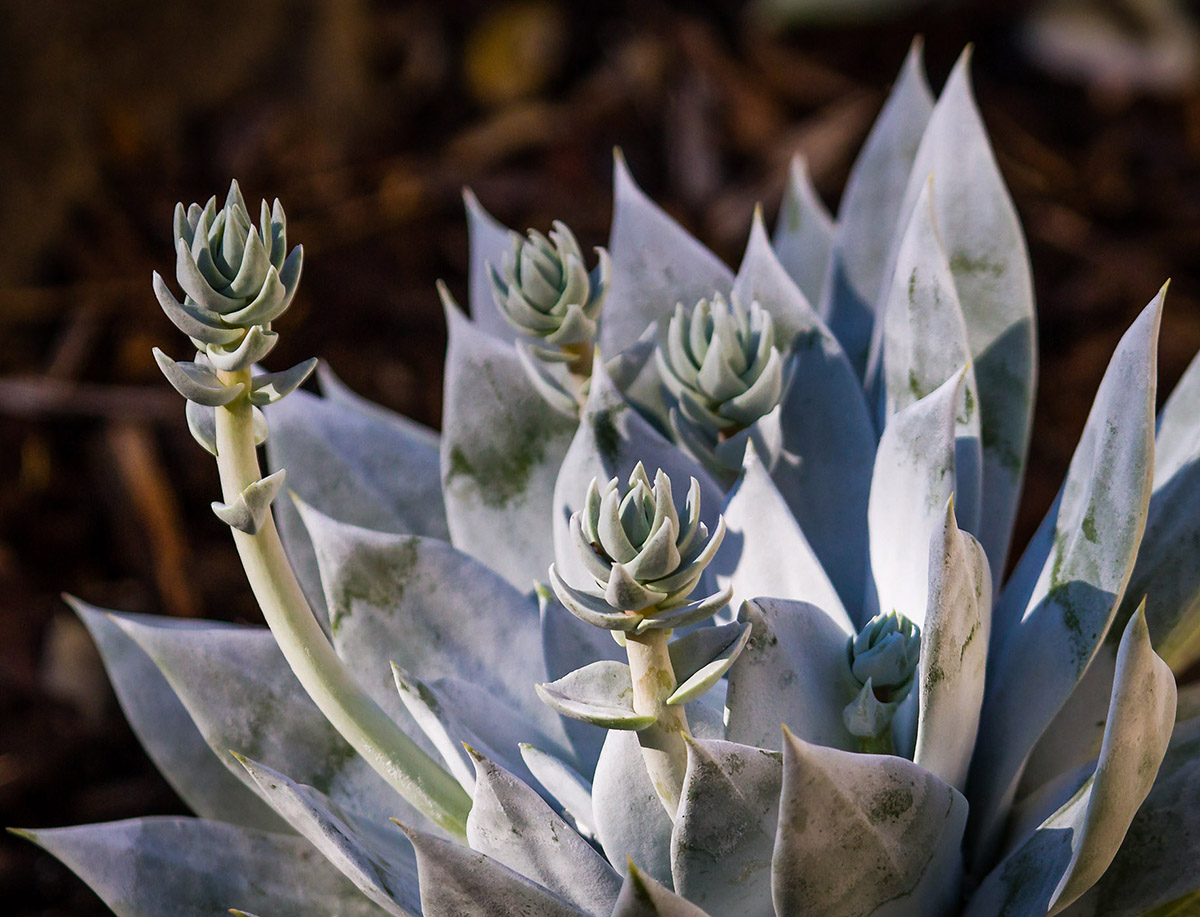
Britton’s liveforever (Dudleya brittonii) (Photo/Denise Dewire)
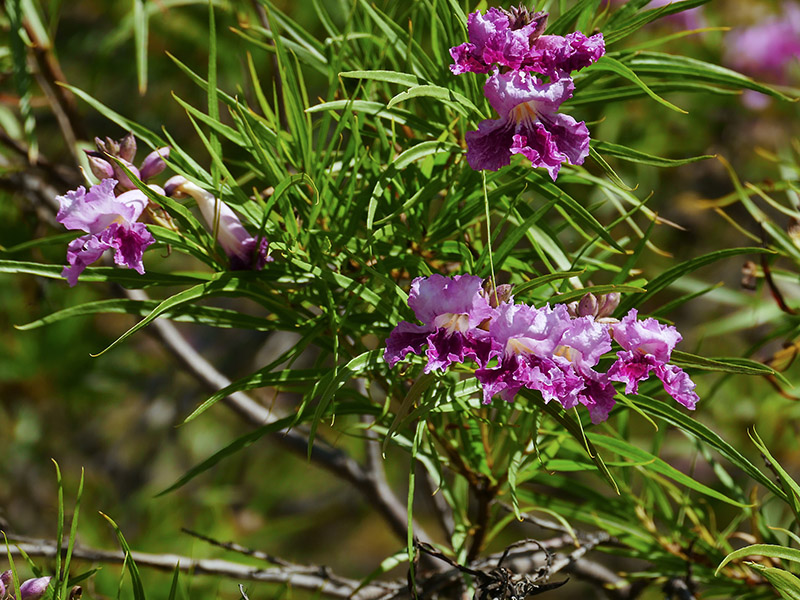
Desert willow (Chilopsis linearis) in bloom (Photo: Randy Wright)
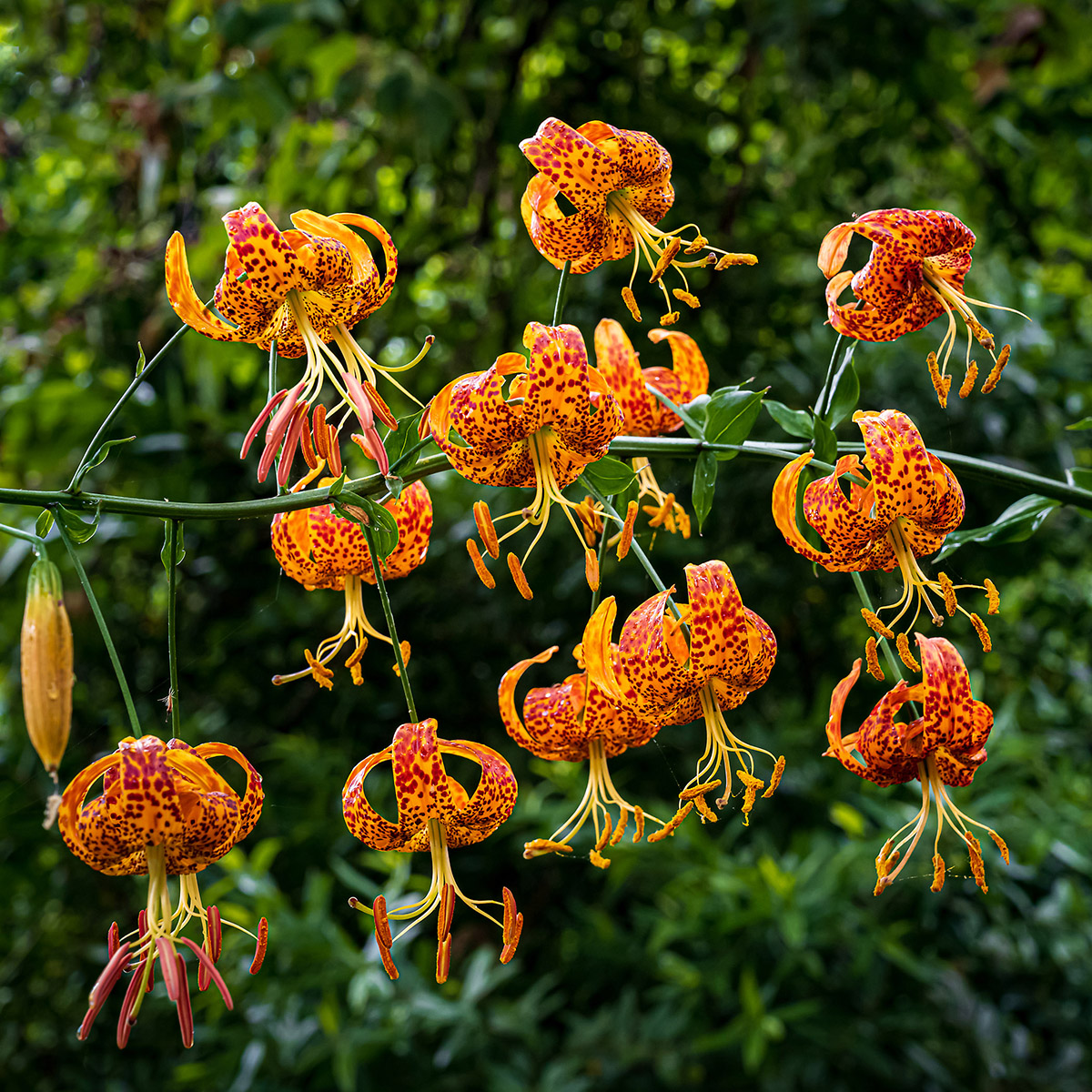
Humboldt’s lily (Lilium homboldtii) in the Redwood Section (Photo: Greg Trainor)
June
Black, white, and purple sages (Salvia spp.)
Attracts butterflies, bees
Liveforevers (Dudleya spp.)
Desert willow (Chilopsis linearis)
Humboldt’s lily (Lilium homboldtii)
Matilija poppy (Romneya coulteri)
Beardtongues (Penstemon spp.)
Attracts butterflies, bees
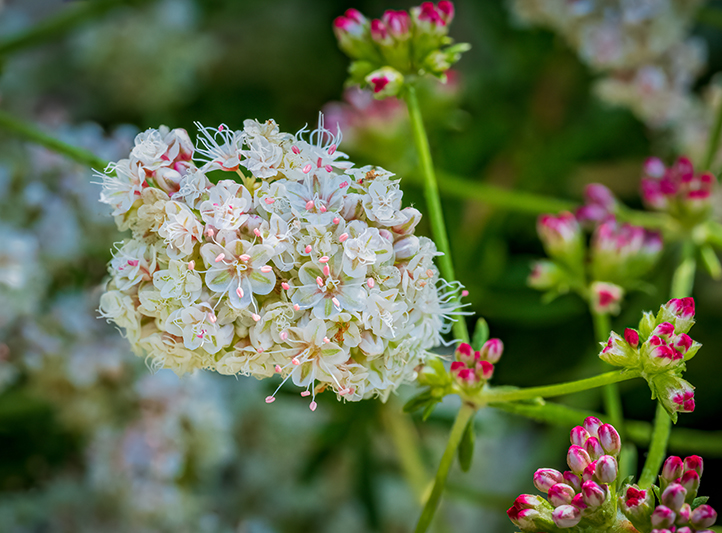
California buckwheat (Eriogonum fasciculatum) (Photo: Greg Trainor)
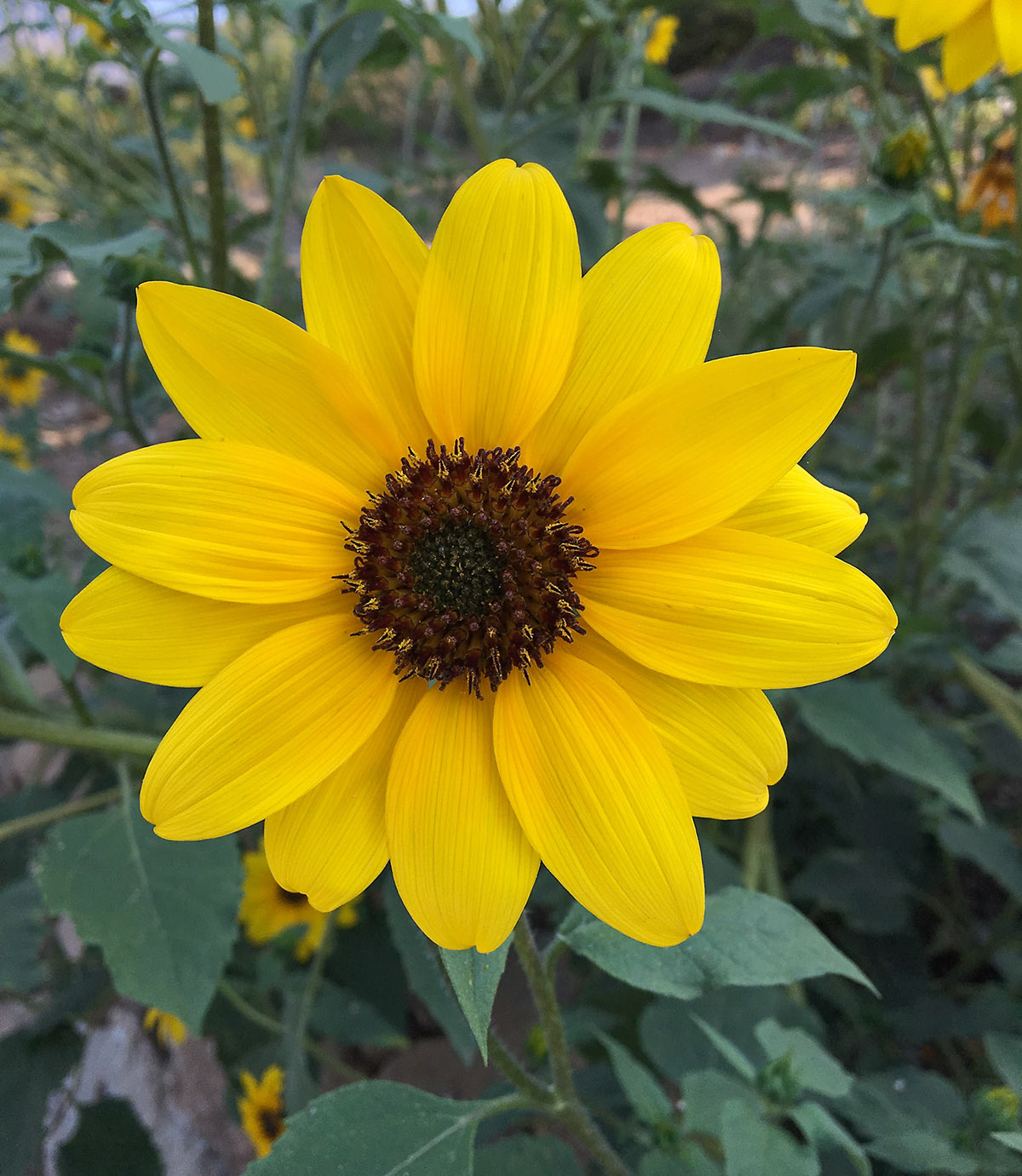
Brittlebush (Encelia californica) (Photo: Elizabeth Collins)
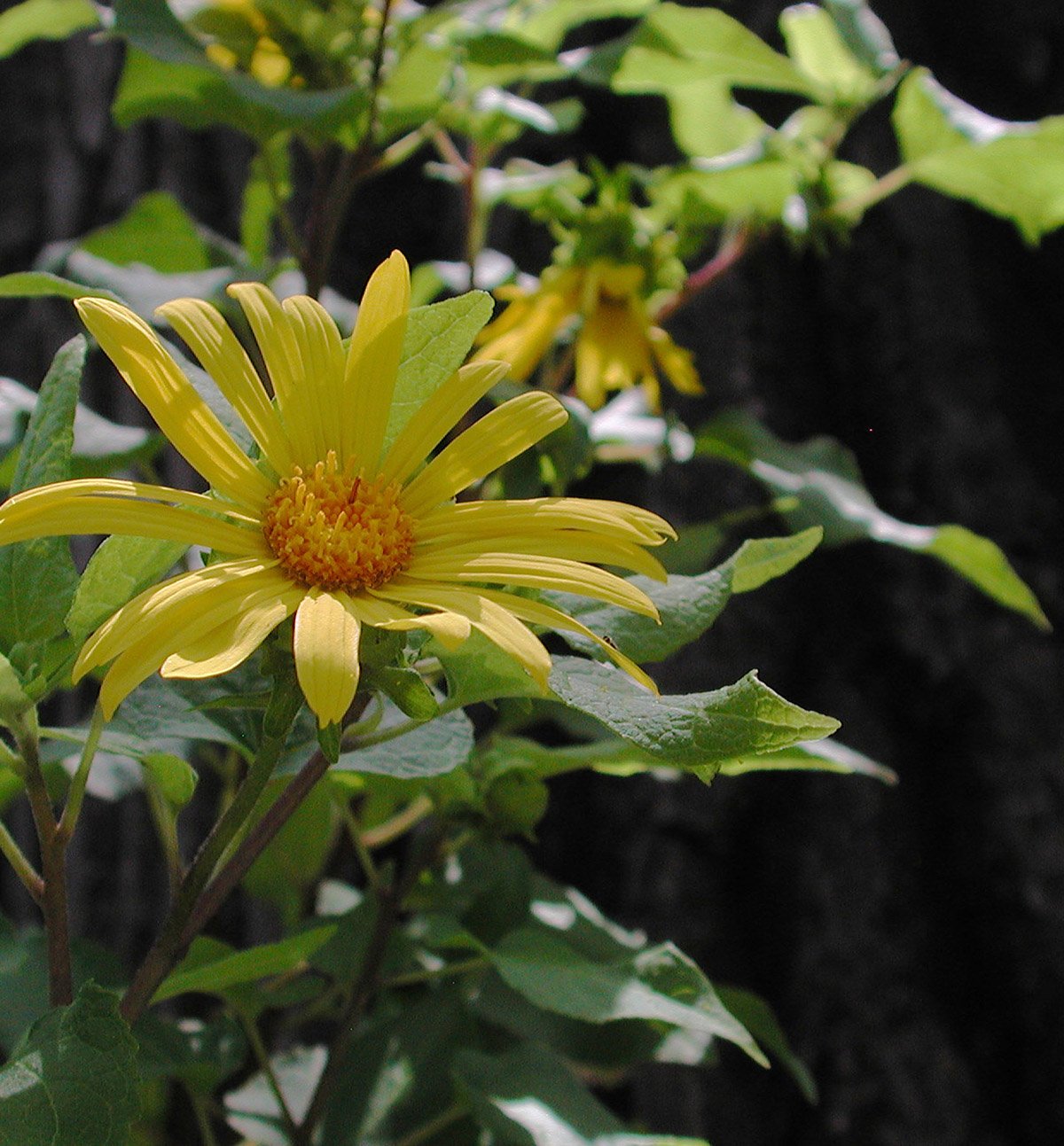
Canyon sunflower (Venegasia carpesioides) (Photo: Jane Auerbach)
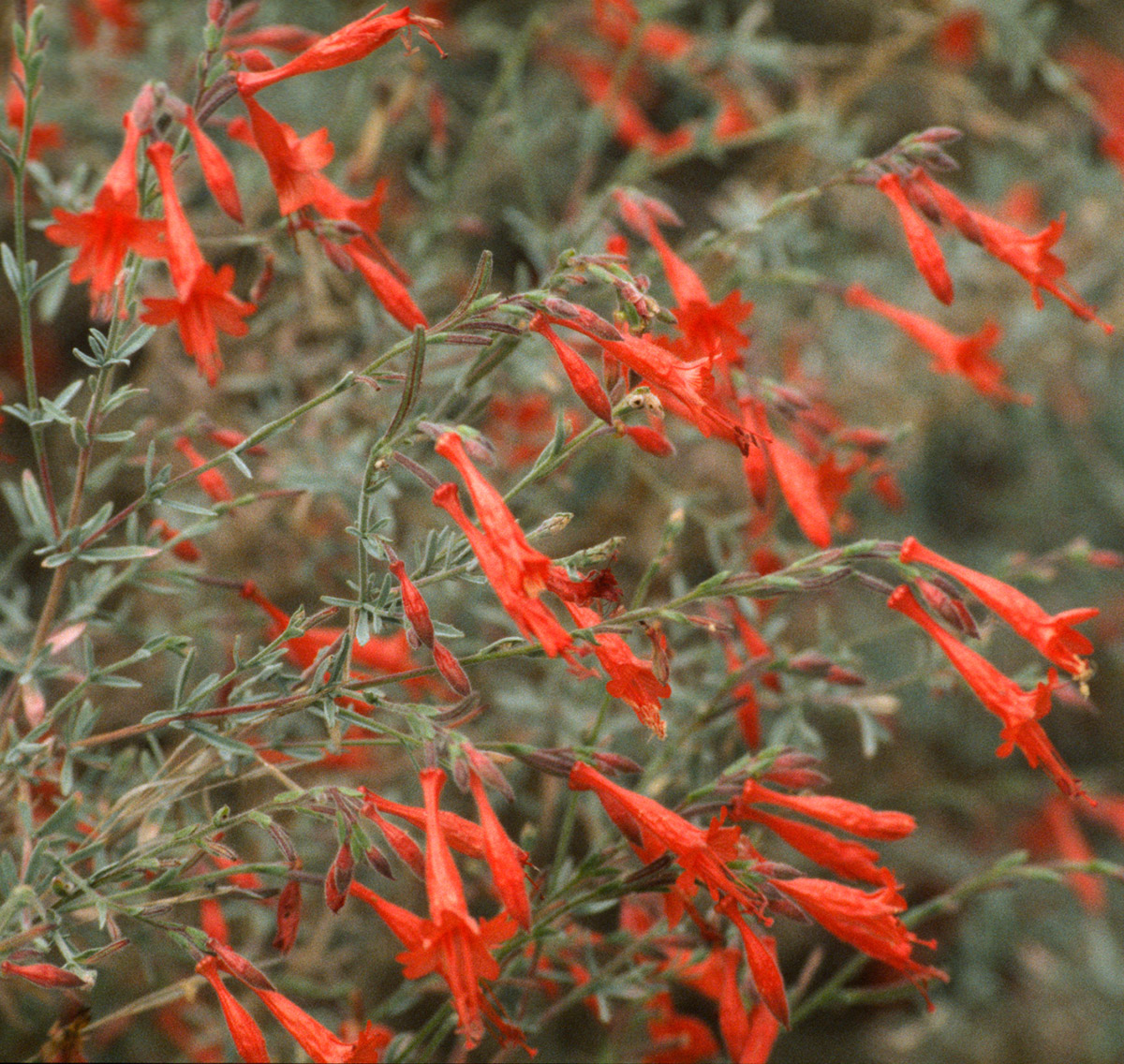
California fuschia (Epilobium canum) (Photo: Dieter H. Wilken)
July
Buckwheats (Eriogonum spp.)
Attracts butterflies
Brittlebush (Encelia californica)
Canyon sunflower (Venegasia carpesioides)
California fuchsia (Epilobium canum)

California goldenrod (Solidago velutina ssp. californica) (Photo: Randy Wright)
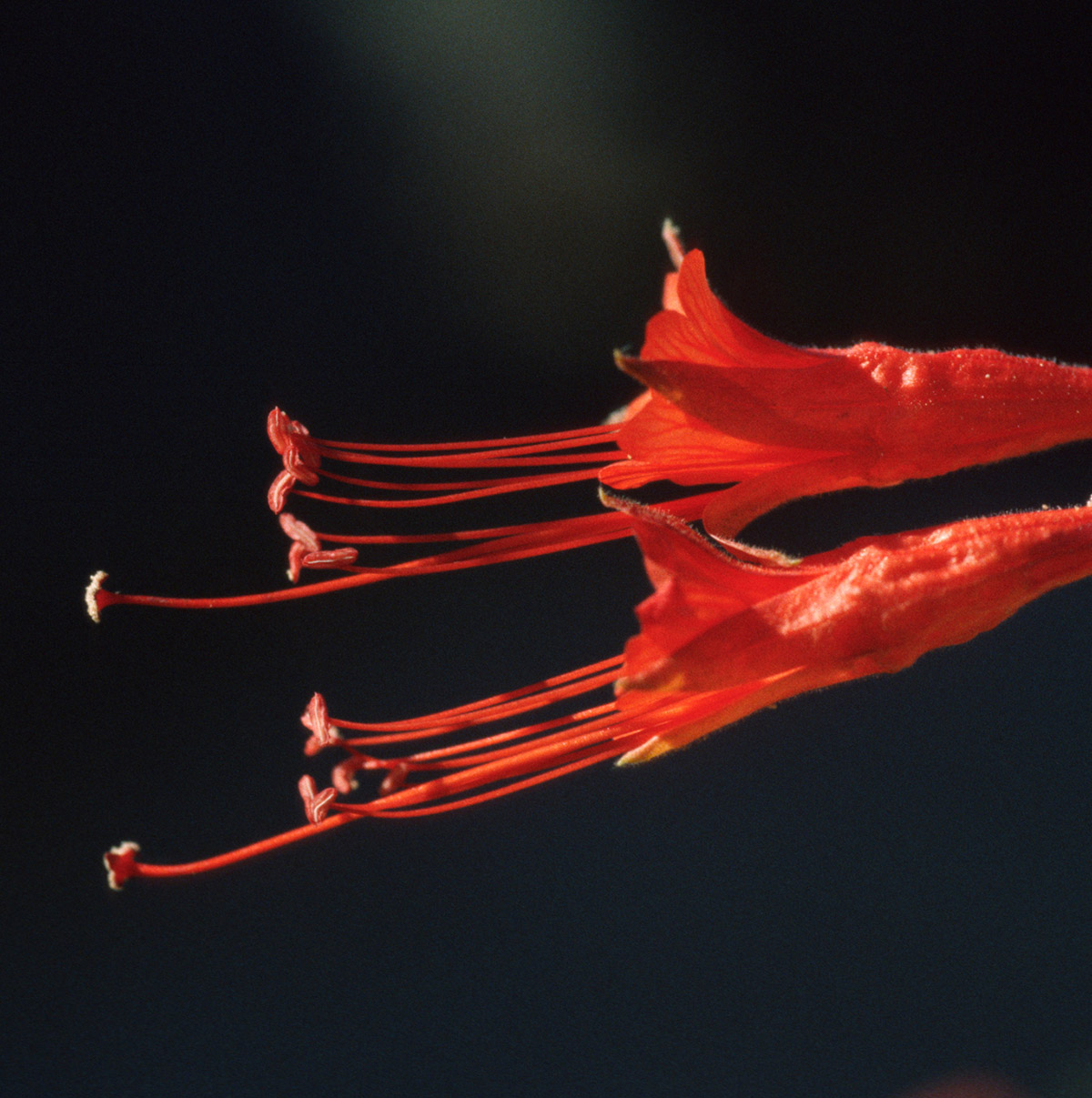
California fuschia (Epilobium canum) (Photo: Dieter H. Wilken)
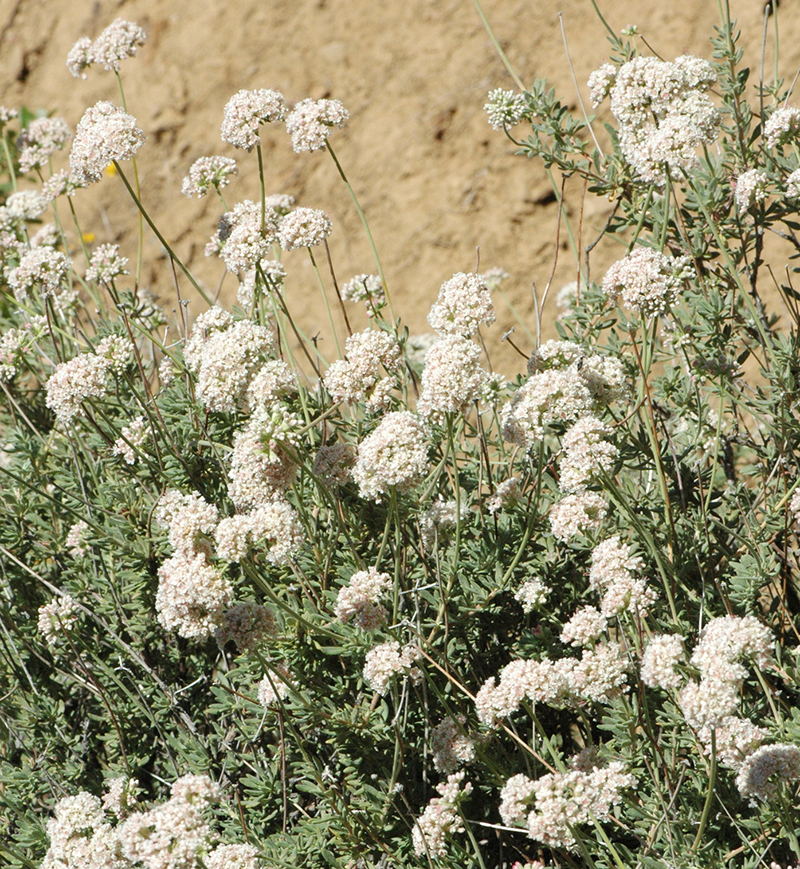
California buckwheat (Eriogonum fasciculatum) (Photo: Robert Muller)

Brittlebush (Encelia californica) (Photo: Elizabeth Collins)
August
Goldenrods (Solidago spp.)
California fuchsia (Epilobium canum)
Attracts hummingbirds
Buckwheats (Eriogonum spp.)
Attracts butterflies
Brittlebush (Encelia californica)
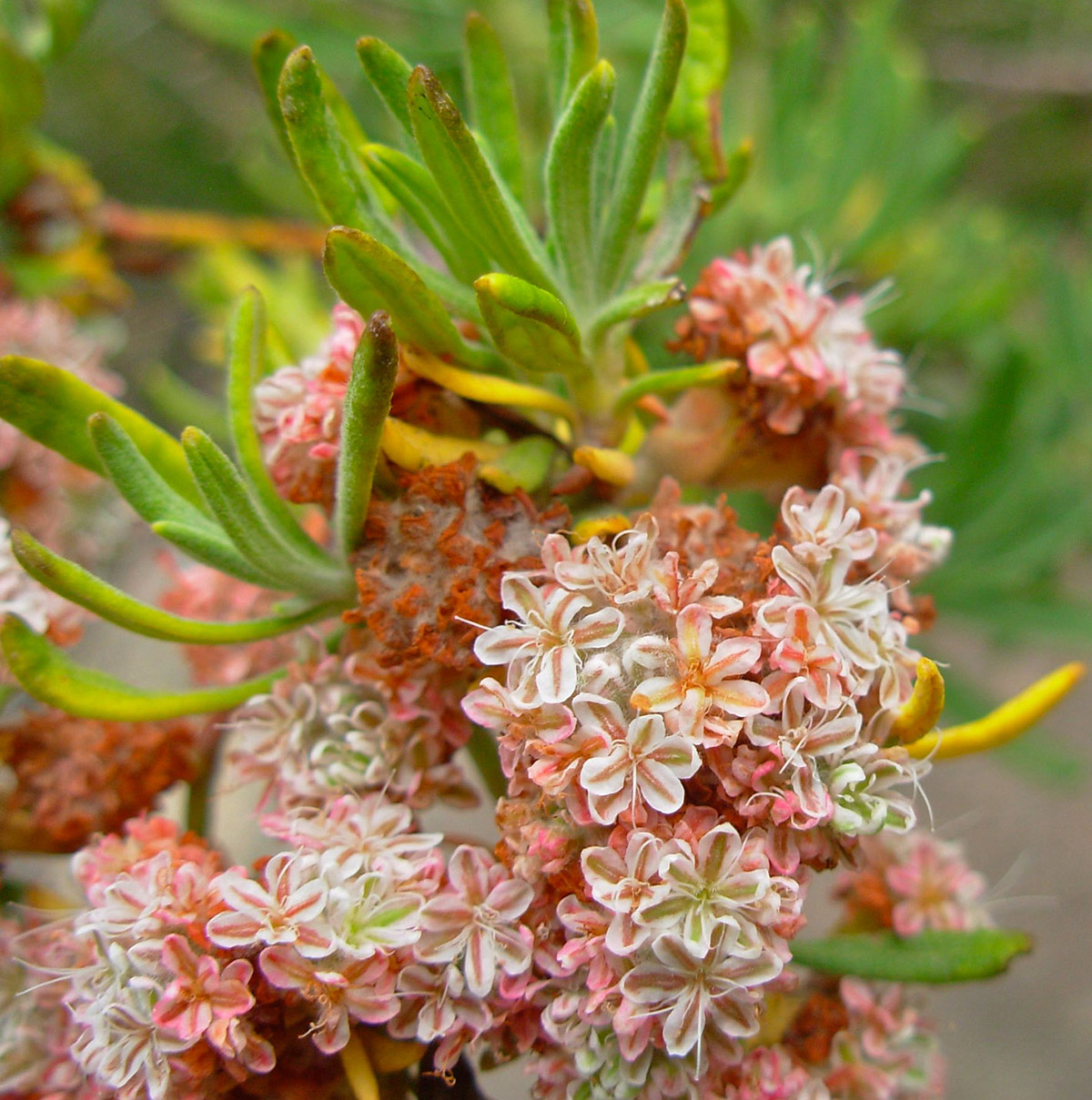
Buckwheat (Eriogonum arborescens) (Photo: Sangeet Khalsa)

California fuschia (Epilobium canum) (Photo: Dieter H. Wilken)
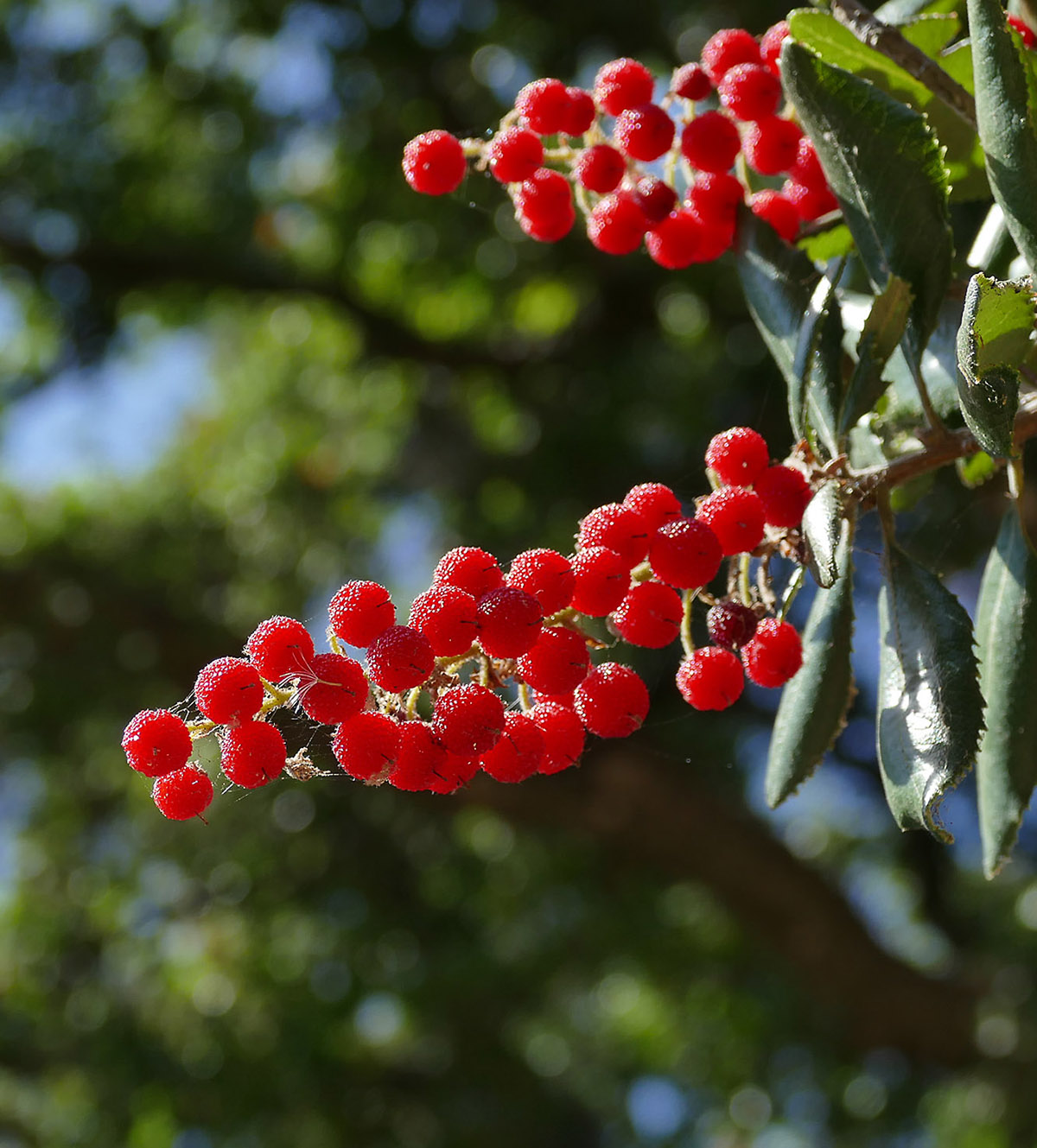
Summer holly (Comarostaphylis diversifolia) (Photo: Randy Wright)
September
Buckwheats (Eriogonum spp.)
Attracts butterflies
California fuchsia (Epilobium canum)
Attracts hummingbirds
Summer holly (Comarostaphylis diversifolia)
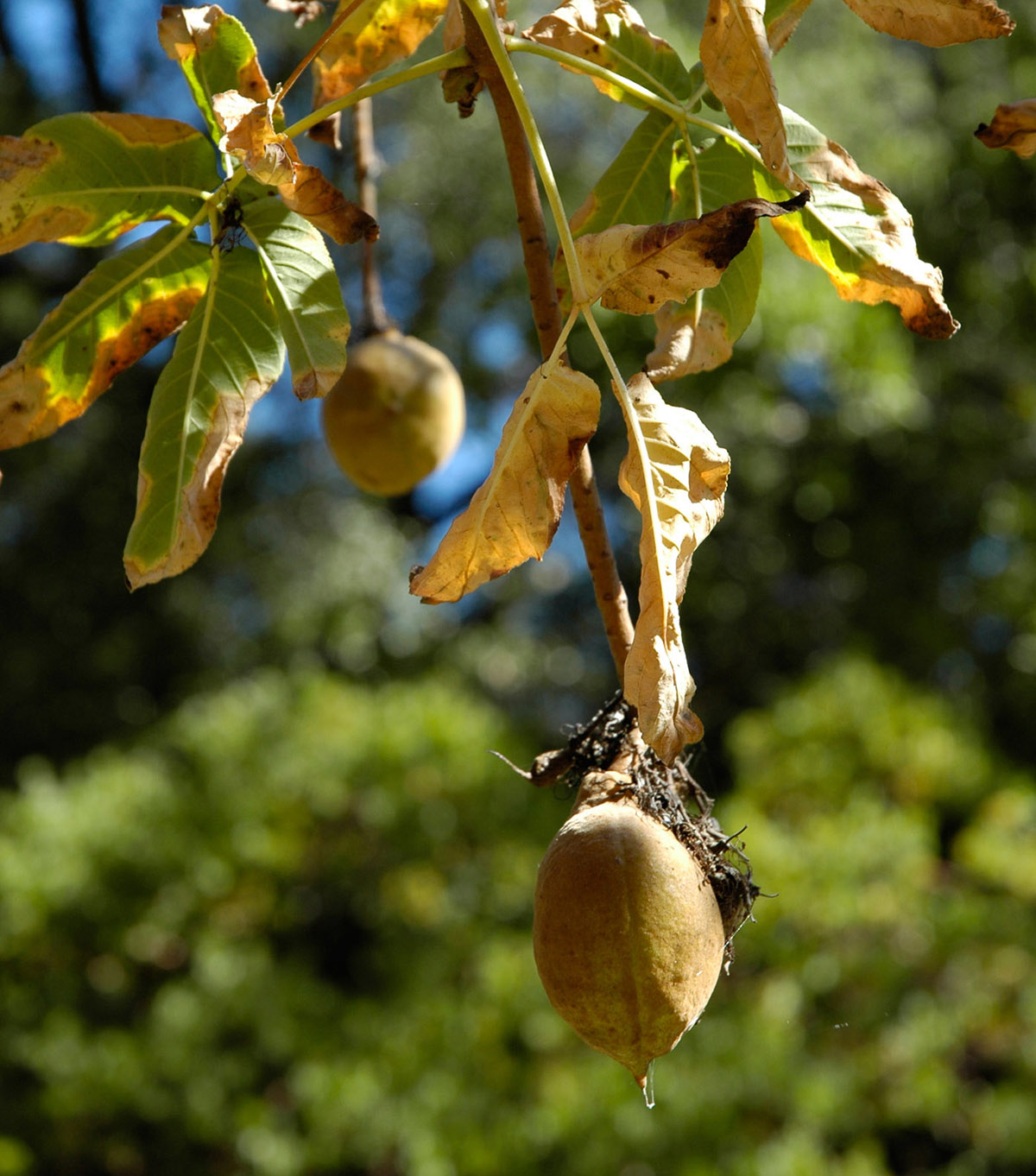
California buckeye (Aesculus californica) in fruit in Arroyo Section (Photo: Tricia Wardlaw)
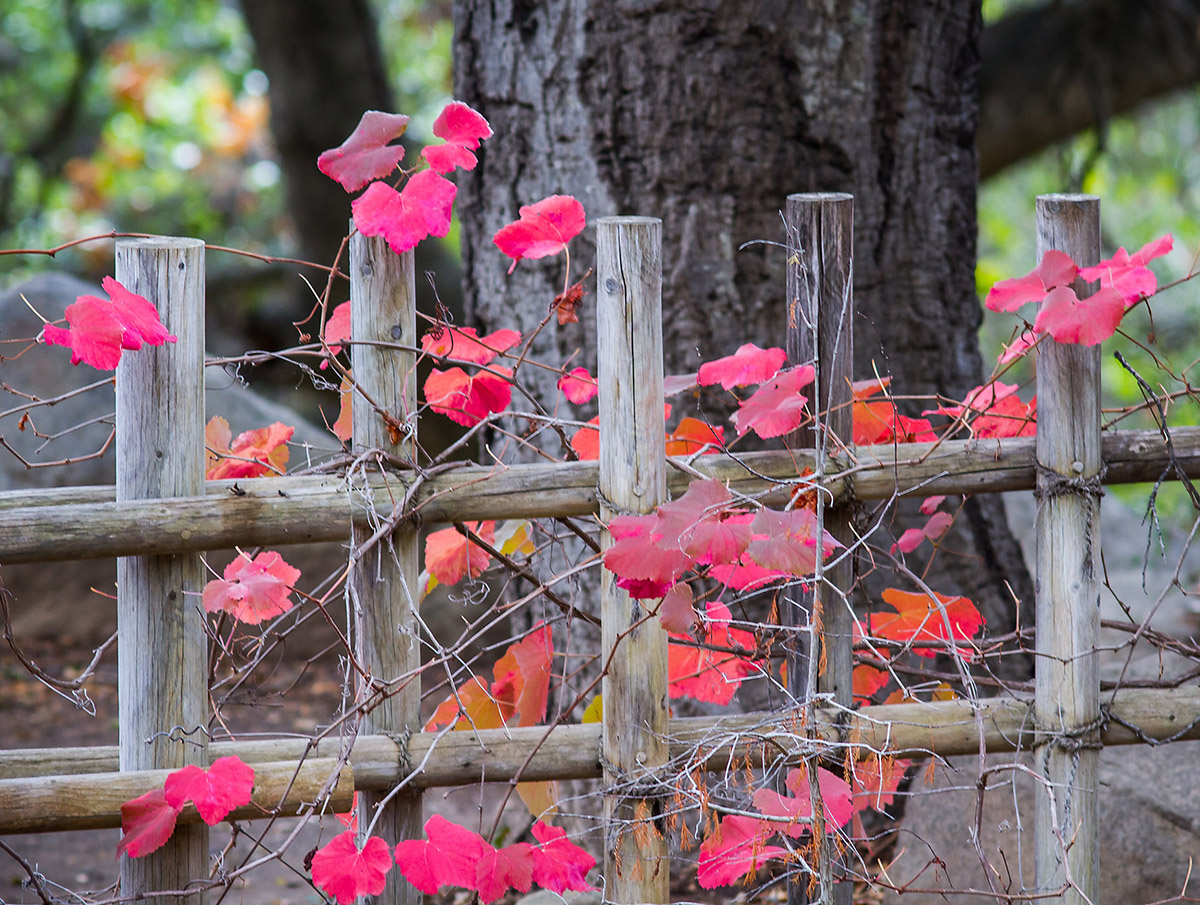
California grape (Vitis californica) leaves in fall color (Photo: Denise Dewire)

California buckwheat (Eriogonum fasciculatum) (Photo: Greg Trainor)

California fuschia (Epilobium canum) (Photo: Dieter H. Wilken)
October
California buckeye (Aesculus californica)
In fruit
California grape (Vitis californica)
Fall color
Buckwheats (Eriogonum spp.)
Attracts butterflies
California fuchsia (Epilobium canum)
Attracts hummingbirds
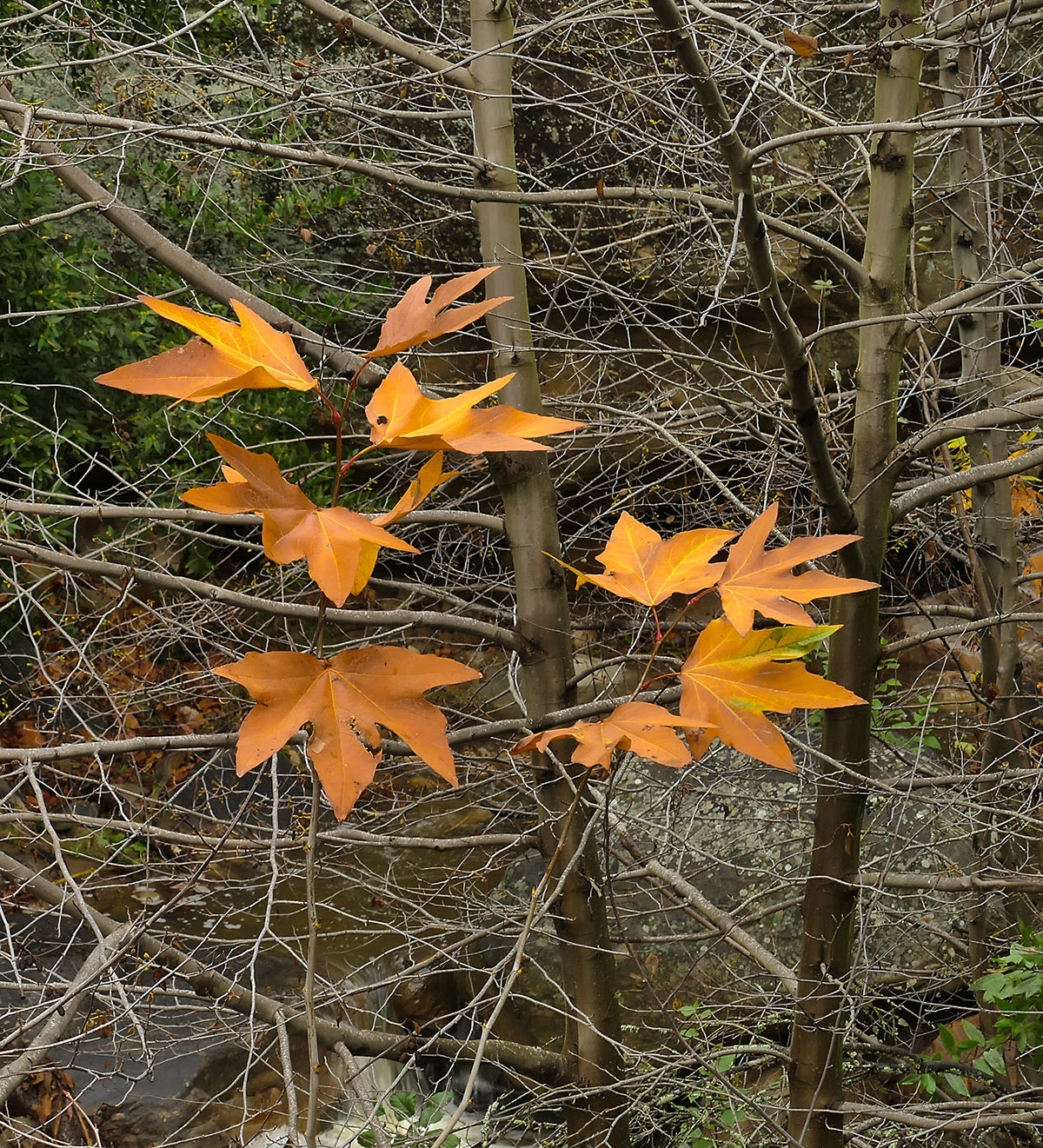
Golden big leaf maple (Acer macroplyllum) leaves in the Canyon Section (Photo: Randy Wright)
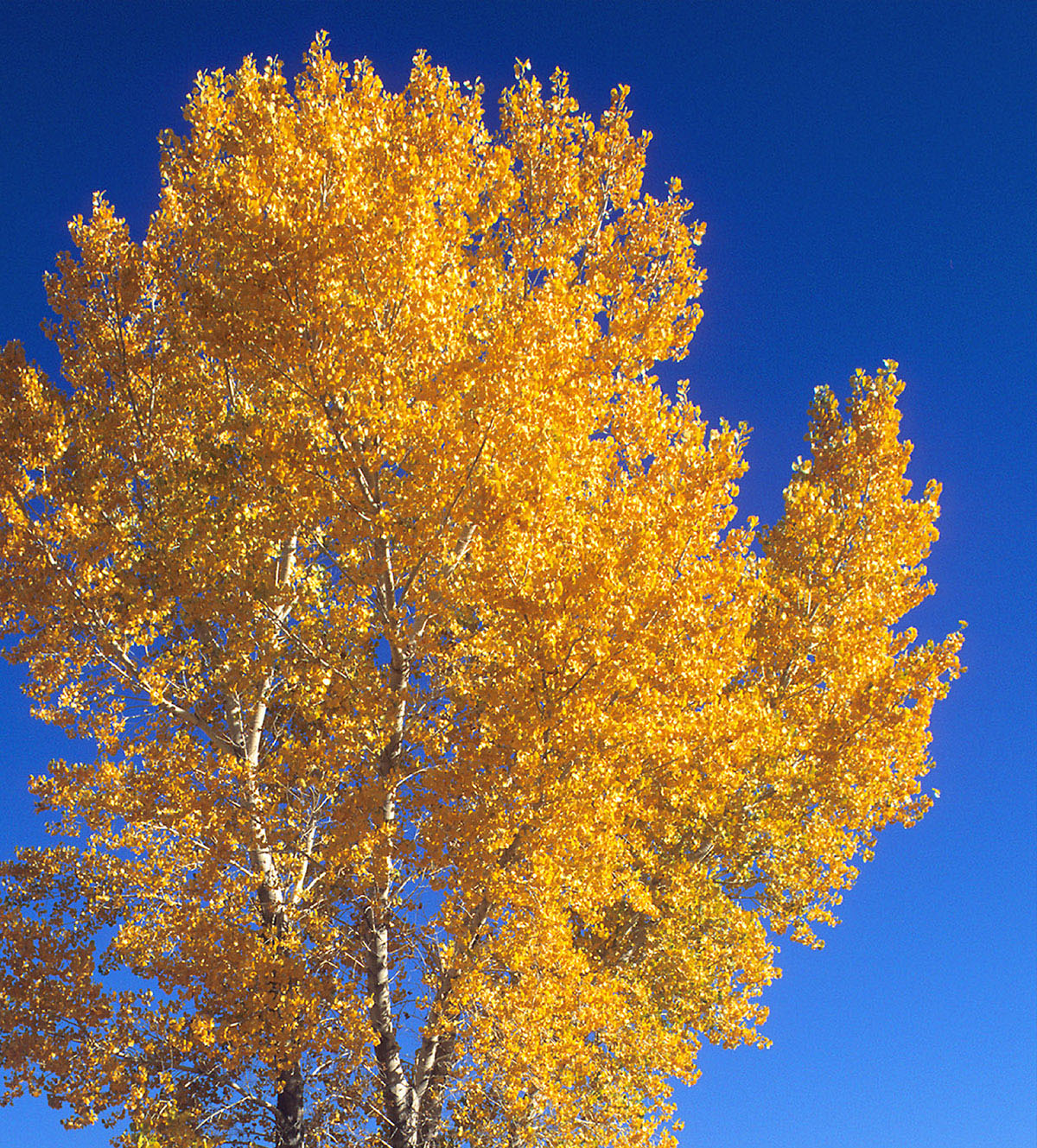
Cottonwood (Populus fremontii) tree (Phot: Ines Roberts)
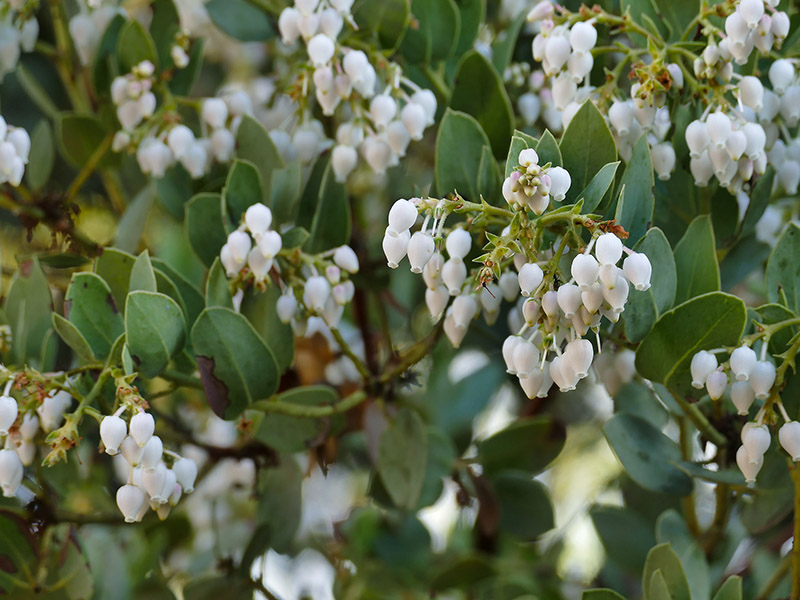
Bigberry manzanita (Arctostaphylos glauca) (Photo: Randy Wright)

California buckeye (Aesculus californica) in fruit in Arroyo Section (Photo: Tricia Wardlaw)
November
Big leaf maple (Acer macroplyllum)
Fall color
Cottonwoods (Populus fremontii spp.)
Fall color
Manzanitas (Arctostaphylos spp.)
California buckeye (Aesculus californica)
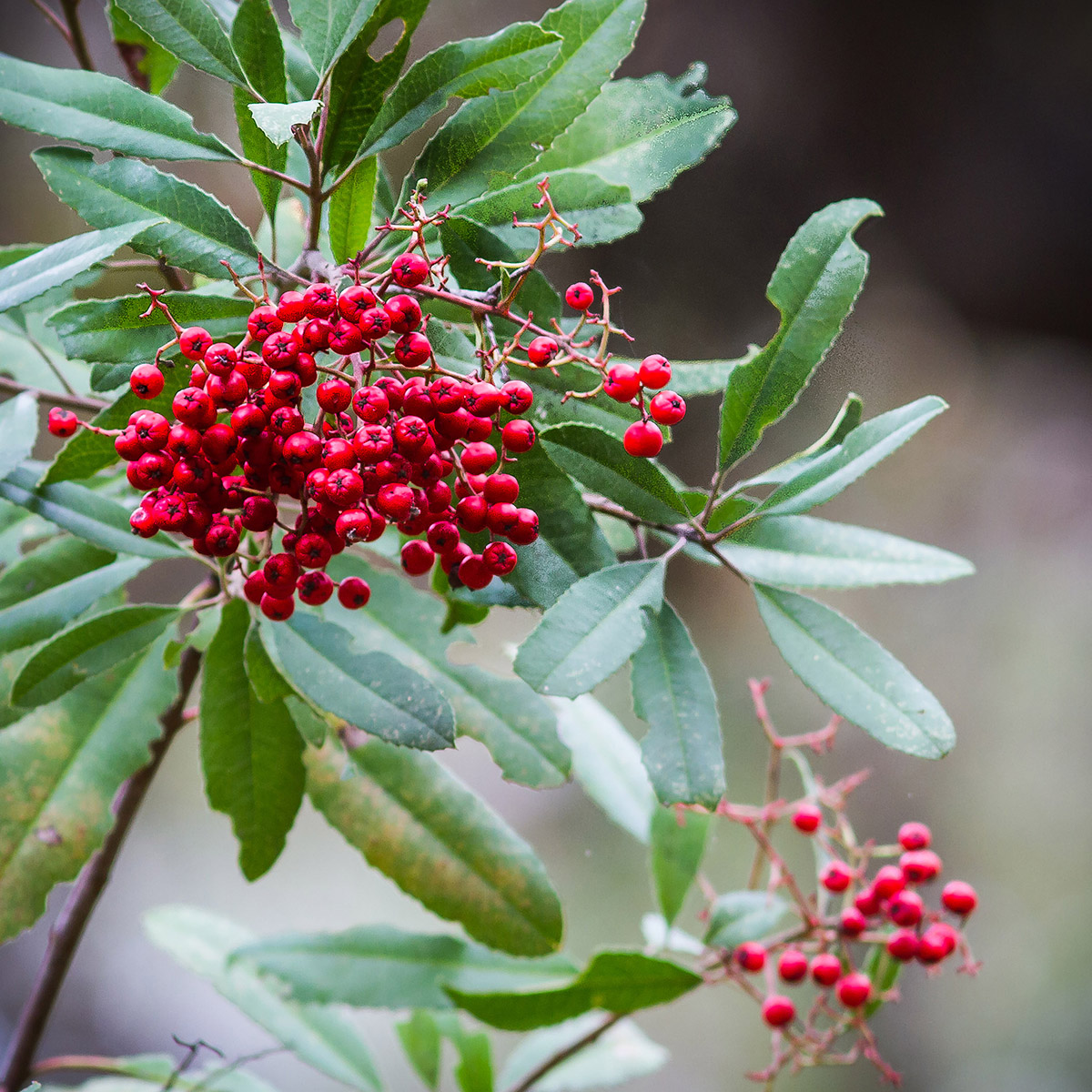
Red berries on Toyon (Heteromeles arbutifolia) (Photo: Denise Dewire)
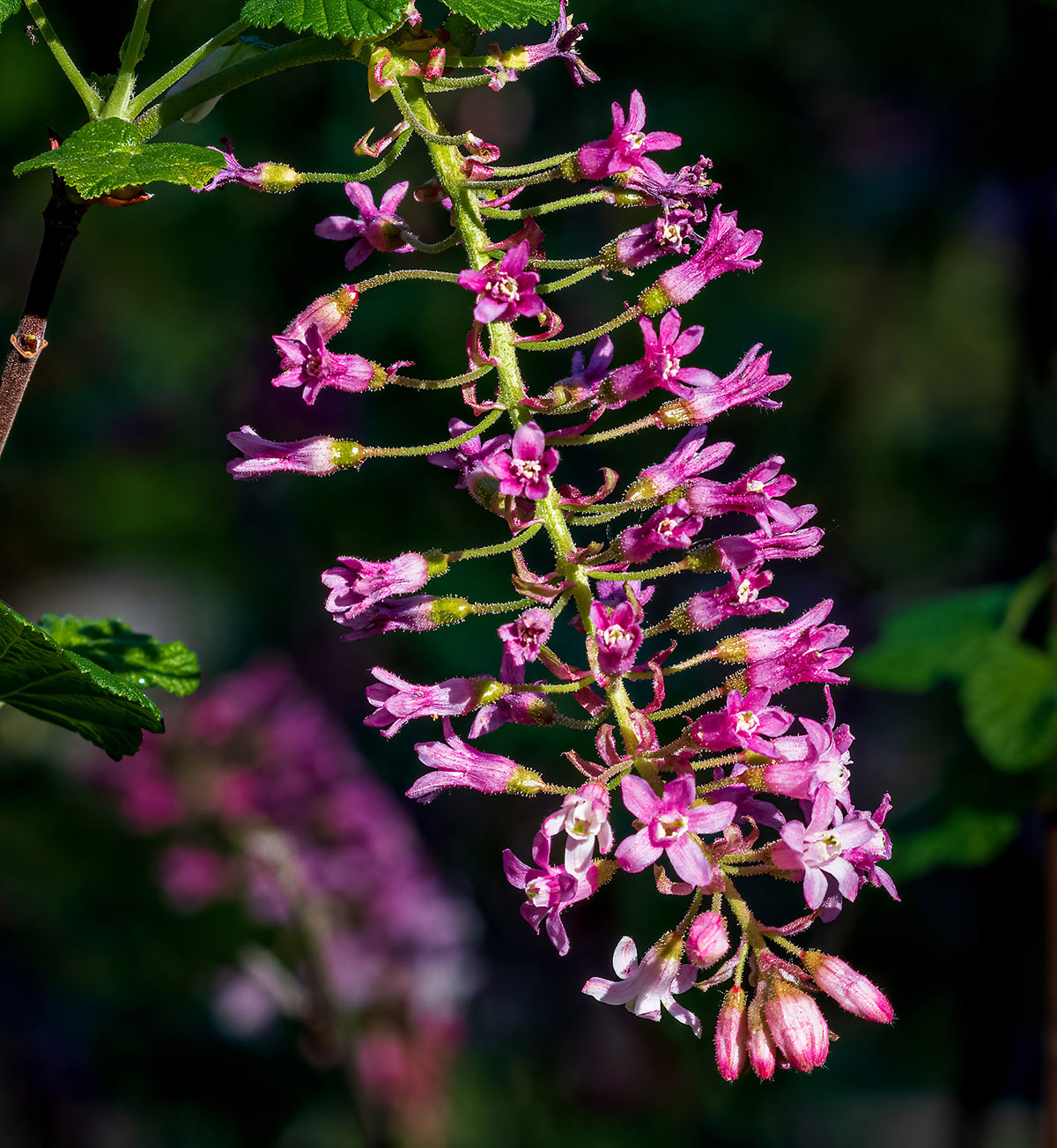
Pink-flowering currant (Ribes sanguineum var. glutinosum) (Photo: Greg Trainor)
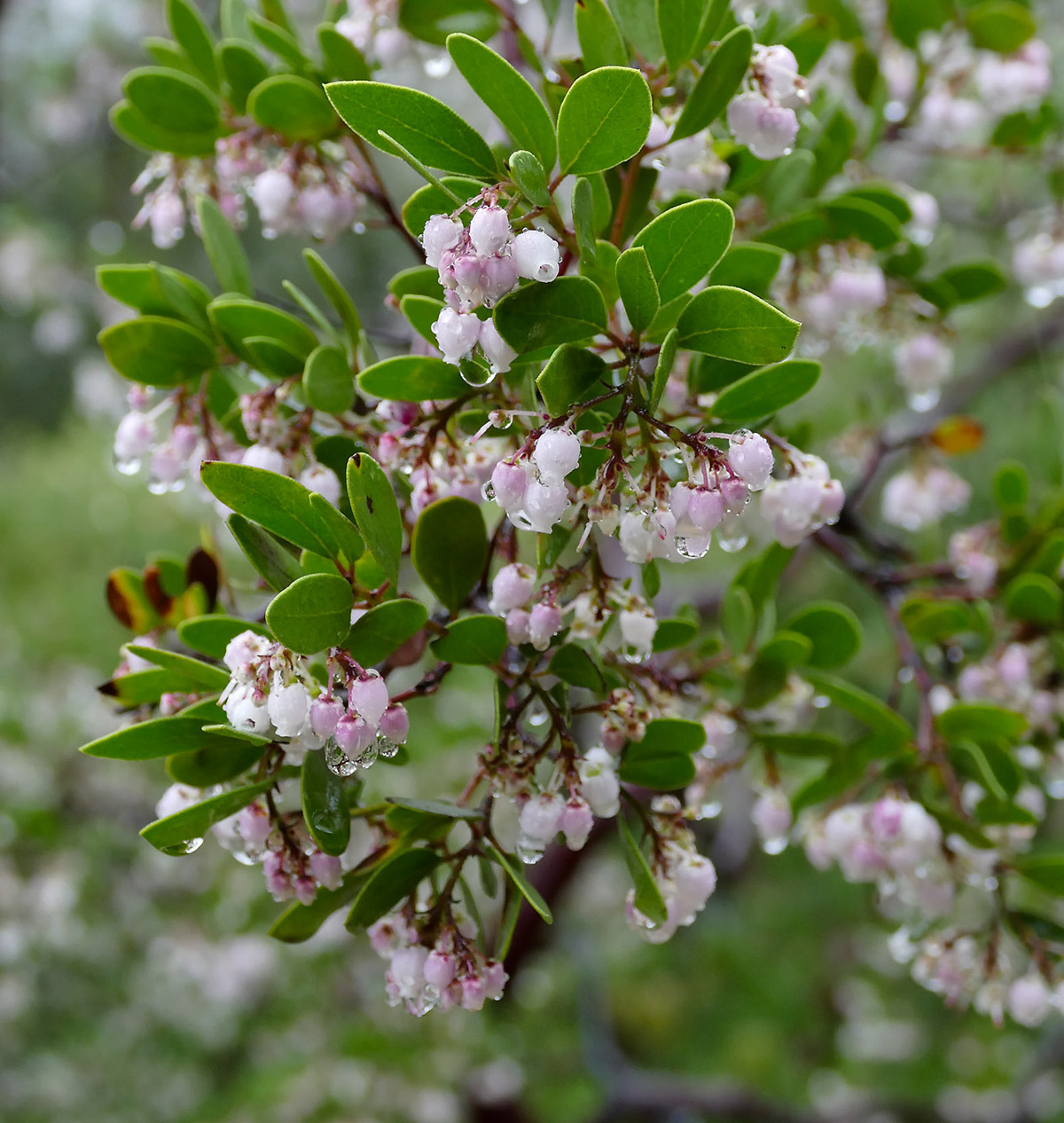
Raiche’s manzanita (Arctostaphylos stanfordiana ssp. raichei) in rain (Photo: Randy Wright)
December
Toyon (Heteromeles arbutifolia)
Red berries
Currants and gooseberries (Ribes spp.)
Manzanitas (Arctostaphylos spp.)
 Donate
Donate